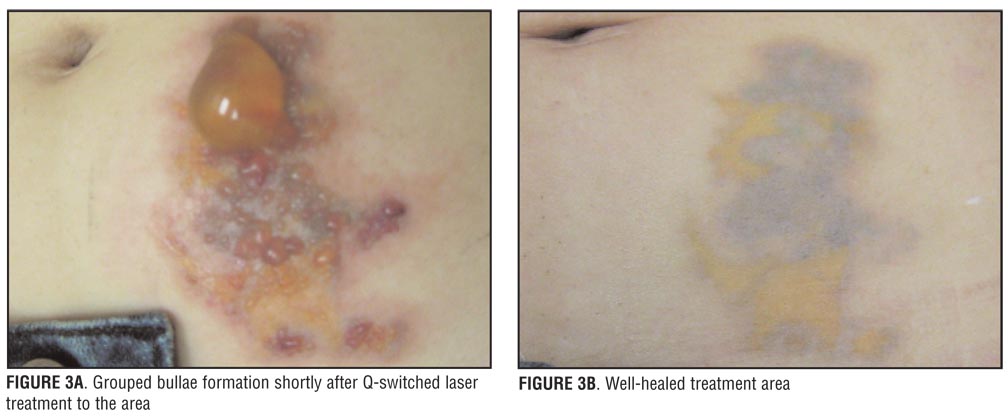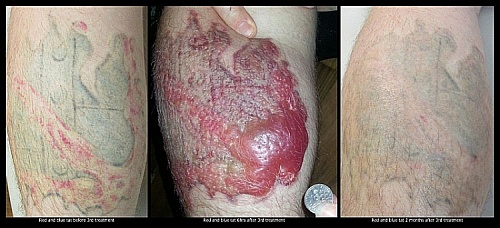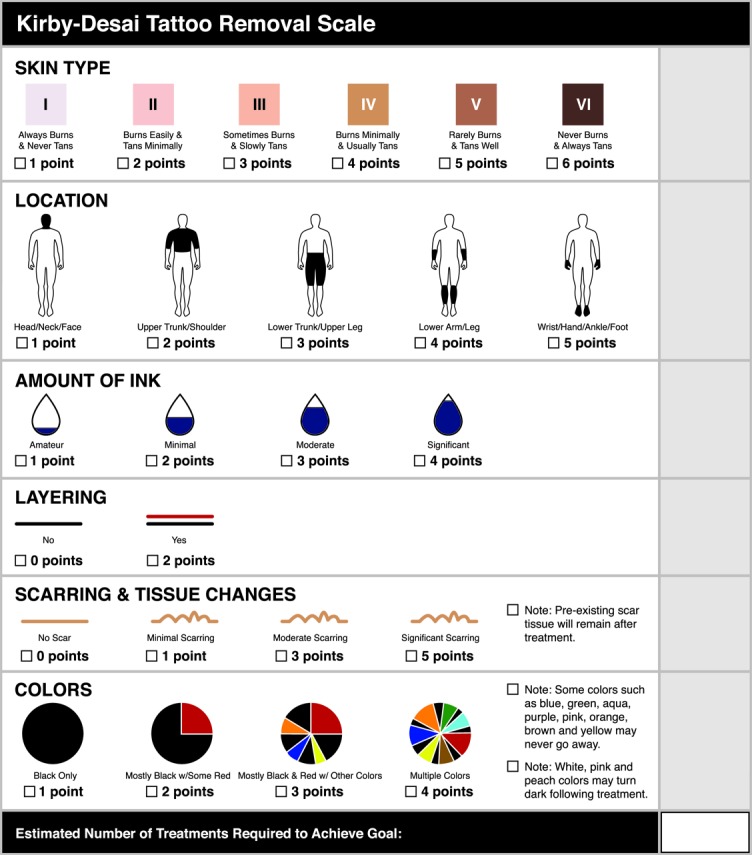[:en]
Laser tattoo removal. It is highly advisable to read the general section on tattoo removal before studying this section focusing on laser tattoo fading.
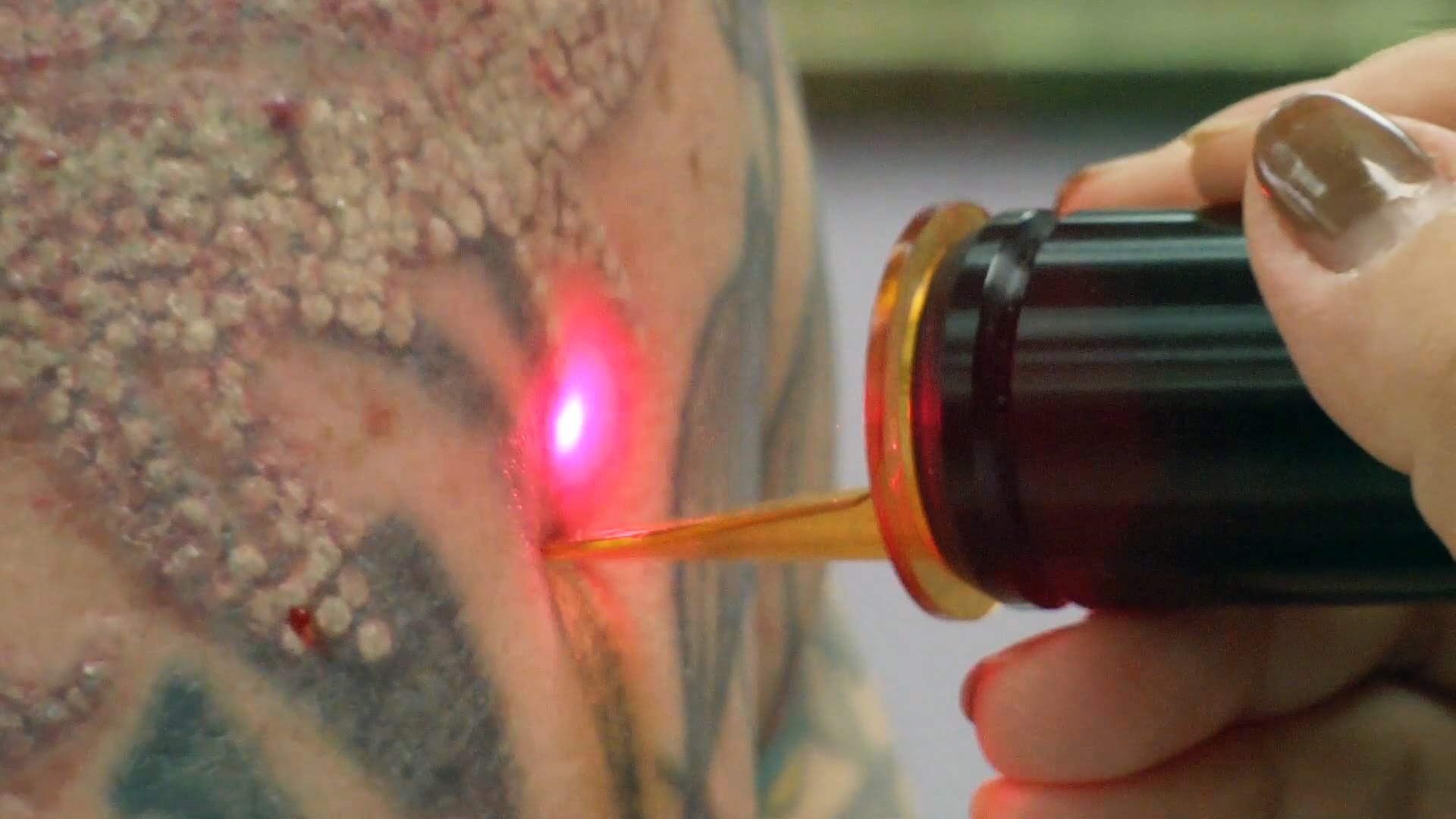
Lasers have been used for this aesthetic application over several years. Tattoo fading lasers are very easy to use and the intensity of the treatment is not dependent on the way the device is used during the treatment itself. This is because as we will see the intensity of the treatment is largely determined by the setting of the device and not by the way the laser is operated. This makes laser tattoo fading devices relatively easy to use. There is little error related to the way the laser is then used during the treatment. The only mistake which can be made is overlapping the lasers burst on the tattoo while operating the device. However, this is very easily avoided as the operator can appreciate the frosting caused by the laser and avoid treating the area again.

Laser tattoo fading treatments are widely advertised as tattoo removal treatments. They are the most popular method to fade tattoos in most western countries.
These aesthetic treatments only last a few minutes, are straightforward to perform and the price per minute for this type of treatment is relatively high. Therefore very profitable to the cosmetic clinics performing them. This is because the duration of the treatment per se is very brief and the price charged for treatment is relatively high (because the clientèle is usually highly motivated to have their tattoo faded or removed). Also, several numbers of treatments are required to achieve satisfactory results making the cumulative total amount charged relatively high. Both the ever increased demand and the profitability of these treatments to clinics have made laser tattoo fading treatments the most popular aesthetic treatment for this application.
The fading results are relatively easily recognised after the first few sessions when the least resilient colours have faded most. Furthermore, the common perception that the use of lasers in aesthetics "utilises the latest cutting-edge technology" therefore safe and effective has contributed to the rise in popularity of this type of treatment.
The main characteristic of lasers is their capability of emitting a coherent light source at a predetermined frequency (or wavelength). Lasers can also emit a number of different frequencies. The difference between sunlight, including most other artificial light sources and lasers, is that lasers can only emit light at predefined discrete wavelengths. Most lasers can only operate at one predetermined frequency at a time which is set by the laser operator. Lasers are also designed to emit a discrete number of frequencies at a time (multi-frequency/wavelength lasers). The wavelength can be one or multiple but a laser can never emit broadband light energy like most other artificial light sources and other aesthetic devices (e.g. IPL devices).
Multi-frequency lasers are also used for tattoo fading and are advertised as very effective tattoo removal devices. This is because the combination of different wavelengths can bring better fading due to the different penetration of each wavelength and the different effect of each wavelength on each tattoo colour. However, in any case, the main difference between lasers and most other natural or artificial light sources is that the lasers, although can emit a different number of frequencies at a time, cannot emit broadband light. Due to this peculiarity of lasers and the different way each wavelength gets absorbed by the skin, lasers have a broad array of applications in skin treatments. Different wavelengths are absorbed differently by the skin and different penetration of the skin lead to different results and hence different applications are aesthetics.
The depth of the light penetration into the skin is mainly determined by the frequency emitted. The higher the frequency the more superficial the effect of the laser on the skin and the less the light will penetrate inside the skin. Conversely, the lower the frequency the more deeply the light will penetrate inside the skin.
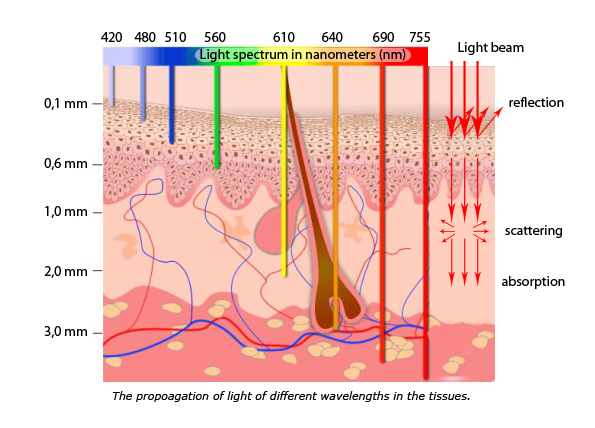
This figure illustrates the way light propagates inside the skin. The shorter wavelengths (blue-green) have only a superficial ablation effect, while the longer wavelengths (red and infra-red) penetrate more deeply into the skin. The higher the wavelength (the lower the frequency) the deeper the penetration of the specific wavelength. This is one of the reasons for the high versatility of lasers. This physical phenomenon allows lasers to have several applications in aesthetics, for example, they are used in skin resurfacing, permanent hair removal, tattoo removal etc. The type of treatment is mainly determined by the frequency, the light intensity and other factors. The above wavelengths are those which produce the typical frosting effects during laser tattoo fading and other laser aesthetic treatments.
The figure above shows how different wavelengths get absorbed by the skin. Generally, the higher the frequency (lower wavelength) the more superficial the effect of the light onto the skin. Higher frequencies light energy to have a relatively low rate of penetration and its action is relatively superficial. Conversely the lower the frequency (higher wavelength) the deeper the penetration of the light radiation into the skin. Therefore in order to accomplish the desired results the appropriate wavelength can be used for any given type of desired aesthetic result.
The difference in the way any given wavelength propagates inside the skin makes lasers extremely useful and versatile devices. This is because in most cases the user can simply change the nature of the aesthetic treatment by varying the wavelength of the device along with other parameters. For example in order to perform a very superficial ablation (e.g. removing superficial skin imperfections, moles, birthmarks, benign lesions or performing a very superficial skin peels) the wavelength used is relatively high (over 420 nm/blue or violet). At these high frequencies, the burning, as well as the skin resurfacing effects, are very superficial. For example, if lasers are used for permanent epilation (permanent hair removal) the degree of light penetration required is a level deeper (orange). This is because in permanent hair removal the laser has to destroy the hair follicle rooted in the dermis. Therefore the laser light has to affect the deeper parts of the dermis where the root of the hair follicle resides. Therefore the wavelength used is lower (in the region of 600 nm or over).
In case the aesthetic treatment demands a deeper level of penetration, then the radiation (light) frequency is lowered. Although lasers can be used for permanent hair removal the devices widely used for this application are IPLs.
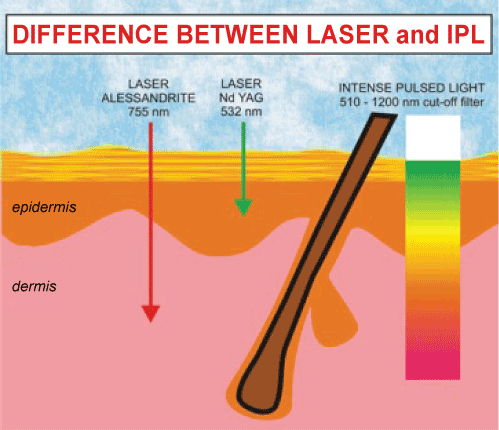
In here, we can appreciate the main difference between lasers (a monochromatic or discrete multi-chromatic light source) and IPL devices (Intense Pulsed Light) generating a broadband light source which has a multi-level of penetration into the skin. The main application of IPL devices is permanent hair removal.
Likewise in case of deep skin resurfacing and laser skin tightening, we are trying to heat up the dermis in order to trigger collagen regeneration. In these case we are looking for deep penetration effects, hence the wavelength chosen can be over 700 nm (red or infra-red). It should be very clear now why Lasers are so versatile used in several skin applications and aesthetic treatments. This is because by varying the wavelength/s emitted along with other few parameters the nature of the treatments changes dramatically.
However, this is an oversimplified description of the way laser lighting penetrates into the skin. There are several other parameters which play a role in the effect of light energy into the skin. One of them is the diameter of the light beam used. Generally the larger the diameter of the light beam the deeper the penetration into the skin conversely the smaller the diameter the more superficial the penetration.

The depth of light penetration into the skin is also related to the diameter of the light beam. Generally the larger the diameter the deeper into the skin the light penetrates. Conversely the smaller the diameter the superficial the penetration. The graph on the right shows how this phenomenon varies with the wavelength used. The red line shows how lower frequencies (1064nm) can penetrate more deeply by increasing the light beam diameter. The yellow line (532nm) shows how the higher the frequencies have less degree of increase in penetration while increasing the diameter.
Spot size, or the width of the laser beam, affects treatment. Light is optically scattered in the skin, like automobile headlights in fog. Larger spot sizes slightly increase the effective penetration depth of the laser light, thus enabling more effective targeting of deeper tattoo pigments. Larger spot sizes also increase the treatment intensity and help achieve the desired tattoo fading effects faster.
Additionally, the skin heating (or skin burning effect) produced by the laser, is related to a number of parameters generally not directly correlated with the depth of laser light penetration. The treatment intensity of the laser is usually calibrated and appreciated in two main ways, by:
- regulating the intensity of the light emission as well as the impulse of the laser while visually appreciating the "frosting" effects (method used in most aesthetic applications including tattoo fading called Q-Switching),
- only setting the intensity and the impulse of the light emission on the device (this is typical of deep skin tightening laser treatments where the "frosting" effects are not visible). This is the case where the frequency of the laser is very low hence the light penetration into the skin is so deep that it is not possible to appreciate the burning effect of the laser visually.
This method relies on varying the intensity of the lighting emission and duration of the pulse (see Q-Switching) while having a visual appreciation of the immediate effects of the laser ablation ("laser frosting"). It is important to realise that the intensity of the treatment is mainly determined by the setting of the device and the visual appreciation is mainly used to make sure the treatment effects are not accidentally exacerbated by overlapping the laser ablation. This method is normally used for removal of benign moles, correction of skin imperfections, superficial laser skin resurfacing treatments as well as laser tattoo removal. The laser operator controls the ablation effects in two ways, both by varying the settings of the device and visually by appreciating the frosting effects on the skin.
An example of appreciating visually the immediate ablation effects caused by the aesthetic treatment during skin resurfacing is shown in the following video. The frosting effect is immediate and it provides the operator with an appreciation of the treatment intensity performed on the client. The user can control the intensity of the light beam by varying the settings of the laser device as well as having a direct visual appreciation of the immediate effects the laser has on the skin.
Also, another example of where the intensity of the treatment is also appreciated visually by the operator during the treatment is the classic laser moles removal. In the video below we can appreciate how the treatment is directly controlled by the operator by repeating the laser ablation during the mole removal procedure.
On the other hand, when the laser ablation or the heating effect is required to be performed deeply into the skin, the operator has no way of visually appreciating the immediate ablation (burning) effects on the skin. For example, in deep laser skin tightening, the effects of the skin treatment are not immediately visible (with frosting or other immediate visible skin reactions), therefore the treatment has to be calibrated only according to previous experience.
The treatment intensity is determined by setting the light intensity and duration of the laser pulse. The longer the duration of the laser pulse the higher the intensity of the treatment, conversely the shorter the pulse the lower the treatment intensity. In these types of laser skin treatments effects of the treatment (redness and swelling) only become visible one or two days following the aesthetic procedure. In these cases, the treatment intensity is only predetermined by calibrating certain settings of the laser device itself.
As an example of low frequency and deep penetration, treatment is the use of a deep laser for skin resurfacing. In the video below we can see an example of deep Laser skin tightening treatment. This is a typical example when the intensity of the treatment is set by regulating certain parameters and there is no direct immediate appreciation of the effects of the laser on the skin.
Laser tattoo removal or more appropriately laser "tattoo fading" work by causing a controlled skin burn in order to fade the tattoo pigments. As we know the tattoo pigments are located inside the dermis. Therefore in order to fade aesthetic tattoos using lasers or any other method a degree of dermal ablation will be inevitably required.
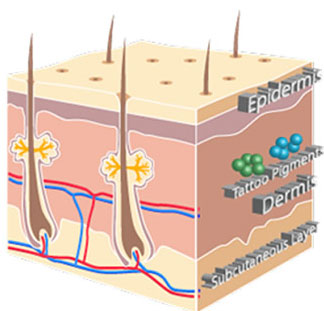
As seen previously the tattoo pigments are located inside the dermis (for more information please click here). Hence in order to reach the tattoo pigments and fade the tattoo, a degree of dermal ablation will be necessary regardless of the method used to fade the tattoo, including laser treatments.
If you are familiar with superficial laser skin resurfacing and the basic principles of laser skin tightening, you will notice the similarities with laser tattoo removal procedures. Like in laser skin resurfacing and laser skin tightening, the laser causes an intentional dermal burn. The main difference in tattoo fading is that the laser device is calibrated in a slightly different way and generally the intensity of the treatment is higher than normal laser skin resurfacing.
In laser skin resurfacing (or laser skin tightening) the laser has to heat up the dermis, the same principle applies to laser tattoo fading. It is the heat (or burn) caused by the laser light that triggers the skin resurfacing and skin tightening. In a similar fashion, the laser treatment speeds up the absorption of the tattoo pigments in stages, both by breaking down some of the pigments and by triggering the skin regeneration caused by the dermal burn inflicted by the laser.
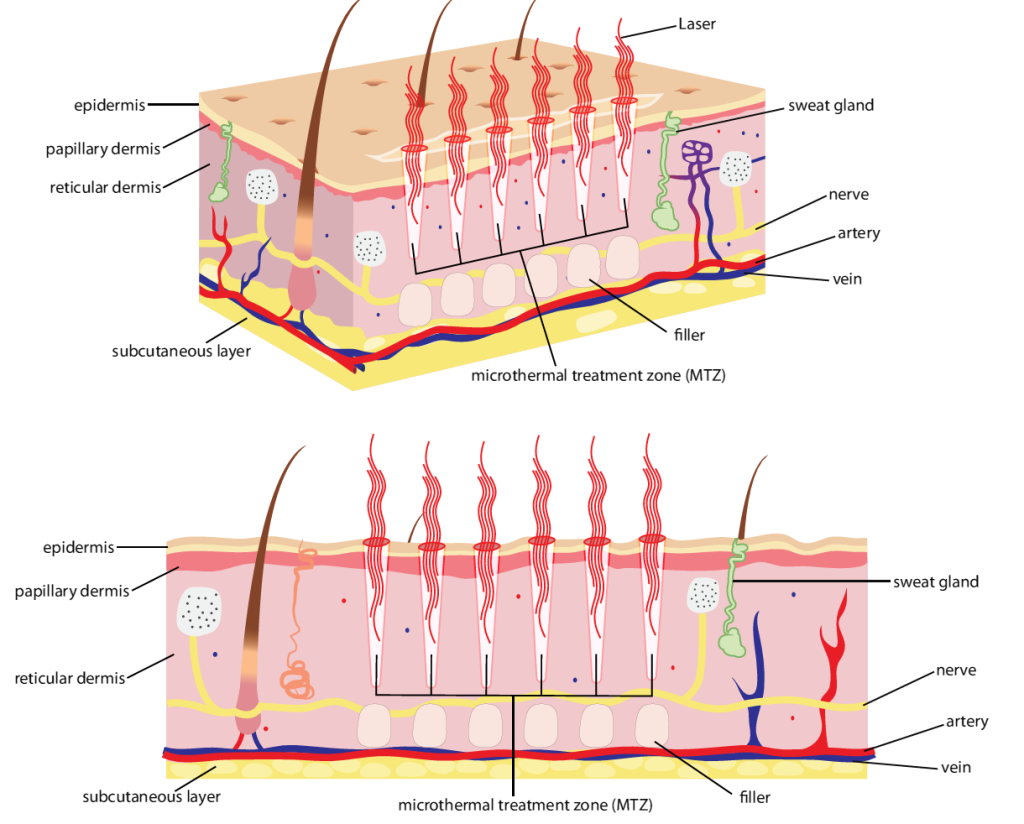
The physics that apply to laser skin resurfacing also apply to laser tattoo fading. As we see in this simplified representation of laser skin resurfacing, the laser light penetrates into the dermis. It is the heat (or burn) caused by the laser light that triggers the skin regeneration and skin tightening.
Similarly to laser skin tightening, during the tattoo fading treatment, the laser causes a dermal ablation which triggers the dermal skin regeneration process, also partly scattering the tattoo pigments. After each treatment, part of the pigments tends to be reabsorbed by the immune system. Some manufacturers advertise selective ablation (burn) targeting of the tattoo pigments, however in any case the laser energy is absorbed by the skin as a whole and not only the tattoo pigments. This is demonstrated by the fact that the skin burn is generated anywhere the laser light is applied and not only on the tattooed area. In case of laser tattoo fading the skin burn is generalised across the treated area as demonstrated by the blistering which forms one or two days after the laser ablation. Unfortunately, there is no currently known tattoo removal or tattoo fading treatment which can selectively target the tattoo pigments during laser treatments. In other words, there is no aesthetic treatment capable of selectively destroying the tattoo pigments alone without also affecting the dermis in one way or another.
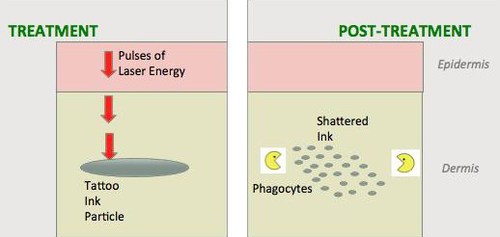
This figure illustrates the basic principle of laser tattoo fading. This is an oversimplified model to illustrate the basic working principle of laser tattoo fading. Part of the light is absorbed by the tattoo pigments and they are partly broken down. The scattered ink is absorbed by the immune system. Not all tattoo ink can be broken down by the laser during the treatment, only a part of the tattoo is absorbed after each session.
The figure below is another oversimplified representation of the laser tattoo fading process because not all wavelengths are absorbed by the dermis at the same depth and in the same way. Lasers can only emit a discrete (finite) number of wavelengths and each wavelength gets absorbed differently by the skin. The deeper the tattoo pigments the harder it will be to break them down without causing some degree of thermal dermal permanent damage (hence permanent adverse effects). This is because in case of very deep pigmentation, most of the laser energy is absorbed by the epidermis and the upper part of the dermis and only a smaller proportion of light is absorbed by the tattoo pigments. Only red and infra-red wavelengths can reach the lower part of the dermis, however even their energy will be partially absorbed by the upper dermis and only a fraction of it will reach the deeper dermis and hence the deep pigments. Normally these wavelengths (red and infrared) are used for deep laser skin resurfacing, laser skin tightening and permanent hair removal.

This is another representation of laser tattoo fading or laser skin resurfacing. We also refer to this process as laser skin resurfacing and this is also a representation of the way the laser light penetrates into the skin for laser skin resurfacing and laser skin tightening. On the left, we can see the tattoo pigments, in the middle an oversimplified representation of the laser tattoo fading treatment. On the right, we can see a representation of the "scattered'" pigments. This is an over simplified representation also because, as we know, lasers can only very seldom scatter all the tattoo pigments within one session especially if the pigments are located particularly deeply inside the dermis.
Below we have yet another representation of laser tattoo pigments fragmentation. Once again this is another oversimplified representation of the complete fragmentation of all tattoo is usually unrealistic within one session. As we already know only part of the tattoo is fragmented and absorbed slightly. Hence not all tattoo pigments are reabsorbed after one tattoo fading procedure. Moreover, not all wavelengths are absorbed by the tattoo pigments and the tattoo fading mostly relies on the skin resurfacing effect to speed up the natural absorption process. Additionally, some tattoo pigment colours do not easily absorb a particular laser wavelength, therefore, being difficult to fade using laser treatments.
In the picture below, the tattoo pigments are represented as being evenly located in the upper part of the dermis. This is an oversimplified representation of the tattoo pigments distribution. The tattoo pigments are seldom evenly distributed inside the dermis at the same depth. In reality, they are often found and distributed at different depths inside the dermis. Some part of the tattoo may have deeper or shallower pigments distribution depending on how the tattoo was drawn at the time and the type of pigments used.
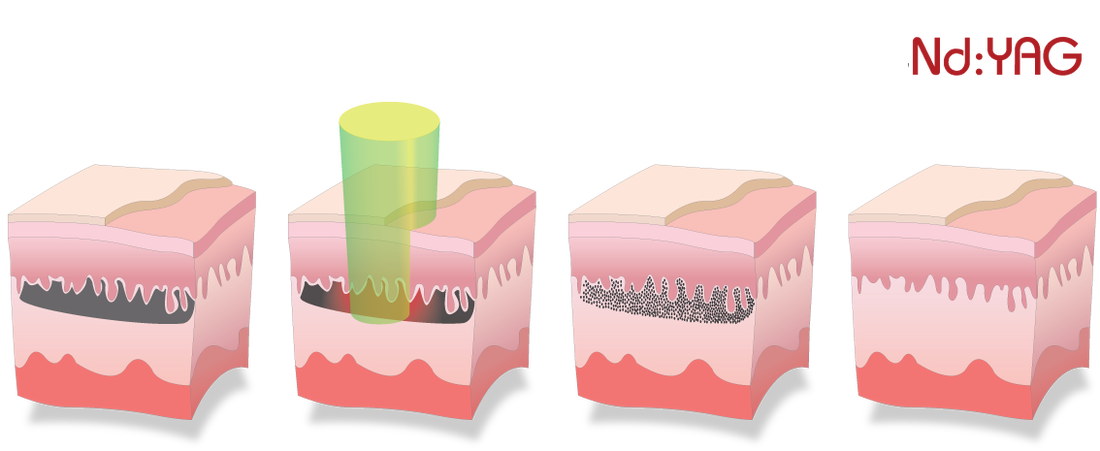
Oversimplified representation of laser pigmentation scattering. Rarely all pigments are scattered all at once. Although this is a rare occurrence, it can happen in case of fading dark colours and in high-quality tattoos like permanent make-up. Also, the distribution of the tattoo pigments is seldom uniform and can be uneven. Also, bear in mind that this is an oversimplified representation of the way laser treatments work for tattoo fading. Not only the tattoo pigments are affected by the laser, but also the skin undergoes a certain degree of burn caused by the laser treatment.
The basic principle of laser tattoo fading is that the deep skin resurfacing caused by the laser forces some of the pigments to be reabsorbed by the immune system. This pigmentation absorption is a natural effect which occurs regardless of time. The deep intense burn caused by the laser speeds up the natural tattoo pigmentation fading. However as seen previously, this process is speeded up by tattoo fading procedures in general and in particular laser tattoo fading.
Tattoo laser fading treatments are an example of where the overall treatment intensity is mainly determined by varying the settings of the laser device. Although the user can intentionally increase the burn inflicted by overlapping the ablation spots while performing the treatment, the overall intensity is generally determined by the setting of the device. This is done by controlling the light emission using very short pulses (Q-Switching). This is one of the reasons for the feeling of being "hit by a strong elastic band" experienced by those who undergo laser fading treatments.
The main principle of operation of tattoo fading lasers is represented in the figure below. These laser devices utilise the ¨Q-Switching¨method to generate an extremely short but highly intense coherent light pulse (generally in the order of nanoseconds). This light impulse is usually several orders of magnitude larger in intensity than lasers generating a constant output.
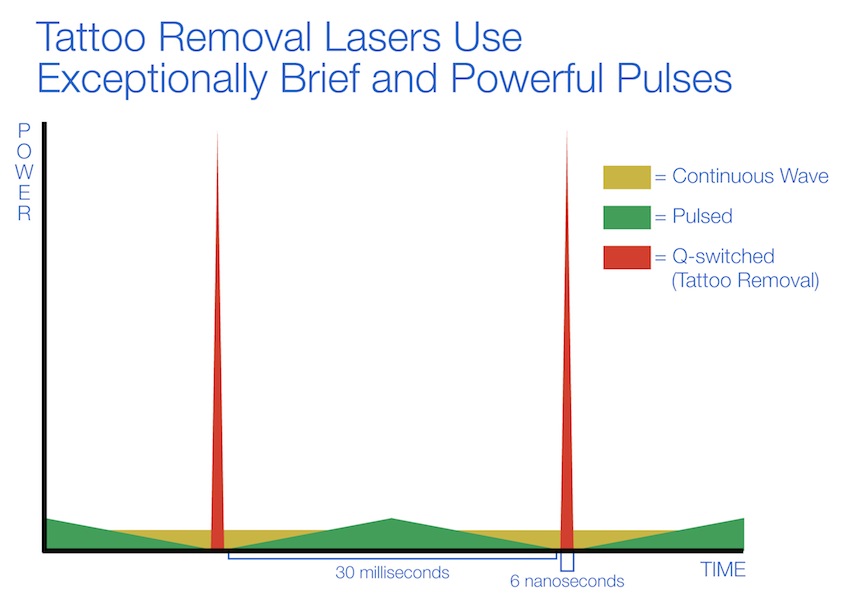
The Q-Switching is the most used laser arrangement for tattoo fading. As seen in the figure the power is extremely high for a very short duration (nano seconds). This ensures that the intensity of the treatment is mainly determined by the way the device is set by the user and not by the way the hand-piece is used during the treatment. Pulse-width or pulse duration is a critical laser parameter. All Q-switched lasers have appropriate pulse durations for tattoo removal.
While using Q-Switching lasers, once the tattoo fading laser has been set up by the user, the operator needs only to make sure the spots do not overlap in order not to unintentionally doubling the burn inflicted on the same area. However this is quite easily avoided becuase every time the light hits the skin it leaves a clear "frosting" spot. In this way the laser treatment intensity is mainly controlled by the setting of the device and there is minimal margin of error during the treatment itself.
In the video below we can see an example of a classic Q-Switched laser for tattoo fading treatment. As we can see there is the usual frosting characteristic of the laser tattoo fading. This frosting immediate reaction to the burn inflicted on to the skin caused by all laser tattoo fading devices.
As we have seen the main principle of operation of tattoo fading devices is Q-Switching. As we can see in the figure below there are several types of Q-Switching devices used for tattoo fading, the lasers can be made to use Ruby, Alexandrite, YAG, or KTP. The material used in the core of the laser has only the effect to determine the main operational frequency of the Q-Switched laser. As we will see one of the main downsides to laser tattoo fading is the fact that lases cannot fade all colours in the same way. Some colours are almost can be impractical to be faded by lasers (especially certain green tones and very bright pigments).
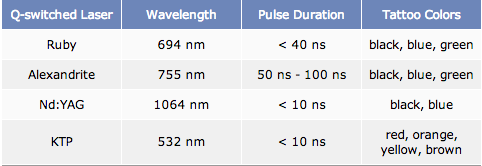
In this table, we can see the main four frequencies used in tattoo fading devices. All tattoo fading devices use the Q-Switching method. Some frequencies can target some tattoo colours only. On the right, we can see the types of colours targeted by each frequency.
Some tattoo fading lasers are advertised as being capable of removing all colours and in one treatment only. These are lasers which combine more than one wavelength. The most common all-in-one tattoo removal lasers combine the four frequencies seen in the table above. However, despite the claims made by the manufacturers, unfortunately, laser tattoo fading treatment is fundamentally colour selective. This means that some colours are faded more than others. Most other tattoo fading treatments are colour blind, this means that they fade all colours indiscriminately. Some latest lasers are advertised to produce a high-intensity pulse lasting few picoseconds, however, no independent investigation on the actual way they operate, their true efficacy and the claims made by the manufacturers have not been verified.
As we have seen most tattoo fading treatments, other than laser tattoo fading devices, are colour blind. Colour blind means that these treatments tend to fade all tattoo colour pigments indiscriminately.
Unfortunately, in case of laser tattoo fading, different tattoo colours fade at different rates. Some colours are not easily absorbed and do not fade significantly after laser treatments, especially certain tones of green as bright colours.

The relative light absorption of each tattoo colour is dependant on the specific wavelength of the light that hits the pigment.The graph shows the relative absorption of each fundamental colour versus the wavelength.
The above graph shows an estimation of the degree of relative light absorption of the tattoo pigments at each wavelength. This has not to be confused with the amount of pigmentation fading after each tattoo fading session. This is because although the light radiation may be absorbed by the particular pigments this does not necessarily translate into a proportional fading of the specific colour pigments.

The figure is an oversimplification of the real effectiveness of tattoo colour fading due to laser treatment. The darker colours are the easiest to fade using lasers.
The above graph serves to show the fact that the inherent physics of light absorption of the tattoo pigments renders the laser treatment outcome inherently dependant on both the wavelength used and the tattoo colours.
The figure on the left is meant to provide a rough idea of the challenges faced in fading certain colours versus others using tattoo fading lasers. As we can see the colour green is not even mentioned in this representative chart. This is because as it is well known in the industry lasers have little or no impact on the green tattoo colours. This does not apply to all tattoo fading treatments, in fact, this limitation only applies to laser tattoo fading. Due to the very nature of lasers, unfortunately, certain wavelengths are more effective on certain tattoo colours and cannot fade others. The easiest tattoo pigments colours to fade are black or dark colours in general, while bright and particularly certain tones of green pigments are the most difficult to fade. Generally the brighter the colours the harder they are to fade using lasers, conversely the darker they are the easier they are to fade using lasers. Sometimes green and bright colours will be far easier to cover up or remove using other treatments rather than persisting in the use of laser fading treatments, which have potential permanent adverse effects.
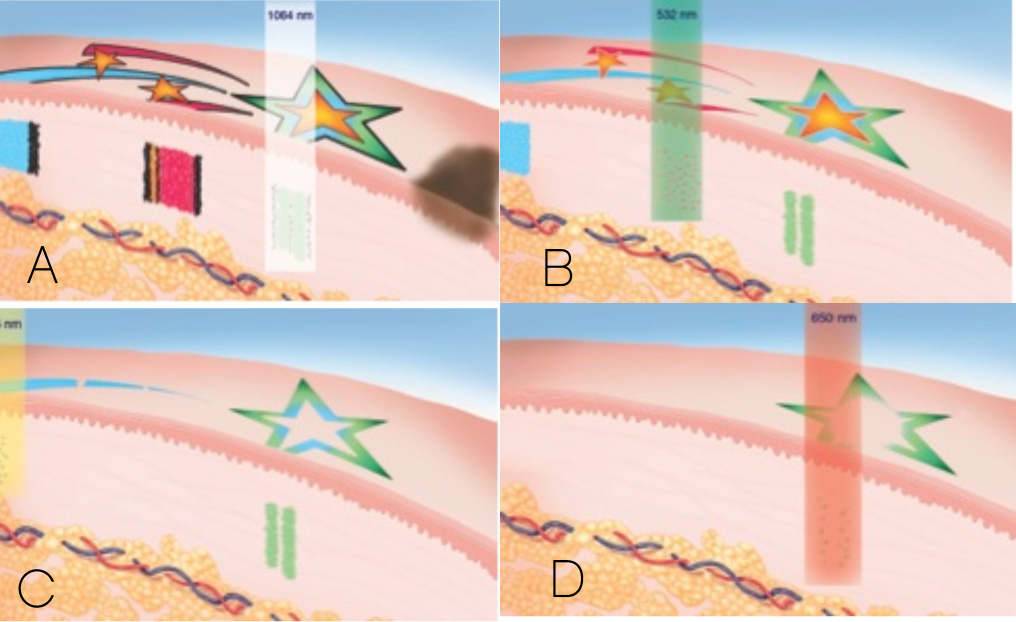
This figure is used only to illustrate what colours are the easiest and most difficult to fade using lasers. (A) represents the initial tattoo, (B) the initial fading of the tattoo after a few sessions, (C) the results after several sessions (where green and bright colours are left), (D) the most difficult colour to be faded is usually left last. Green is the most challenging colour to fade using lasers.
The figure above illustrates how the first colours to be faded are black and dark tones. As we see in B, the easiest colours to be attenuated are the darkest, the brightest are usually left after the first few treatments. In C (after further tattoo fading treatments) the colours left are the brightest and green. Lastly, as seen in D, normally green is the most resilient tattoo pigment with laser tattoo fading. The colour green is so resilient to lasers that it is sometimes considered not feasibly faded using lasers. However, there are manufacturers claiming their new devices are capable of fading bright and all tones green colours indiscriminately. These claims have not been independently verified.
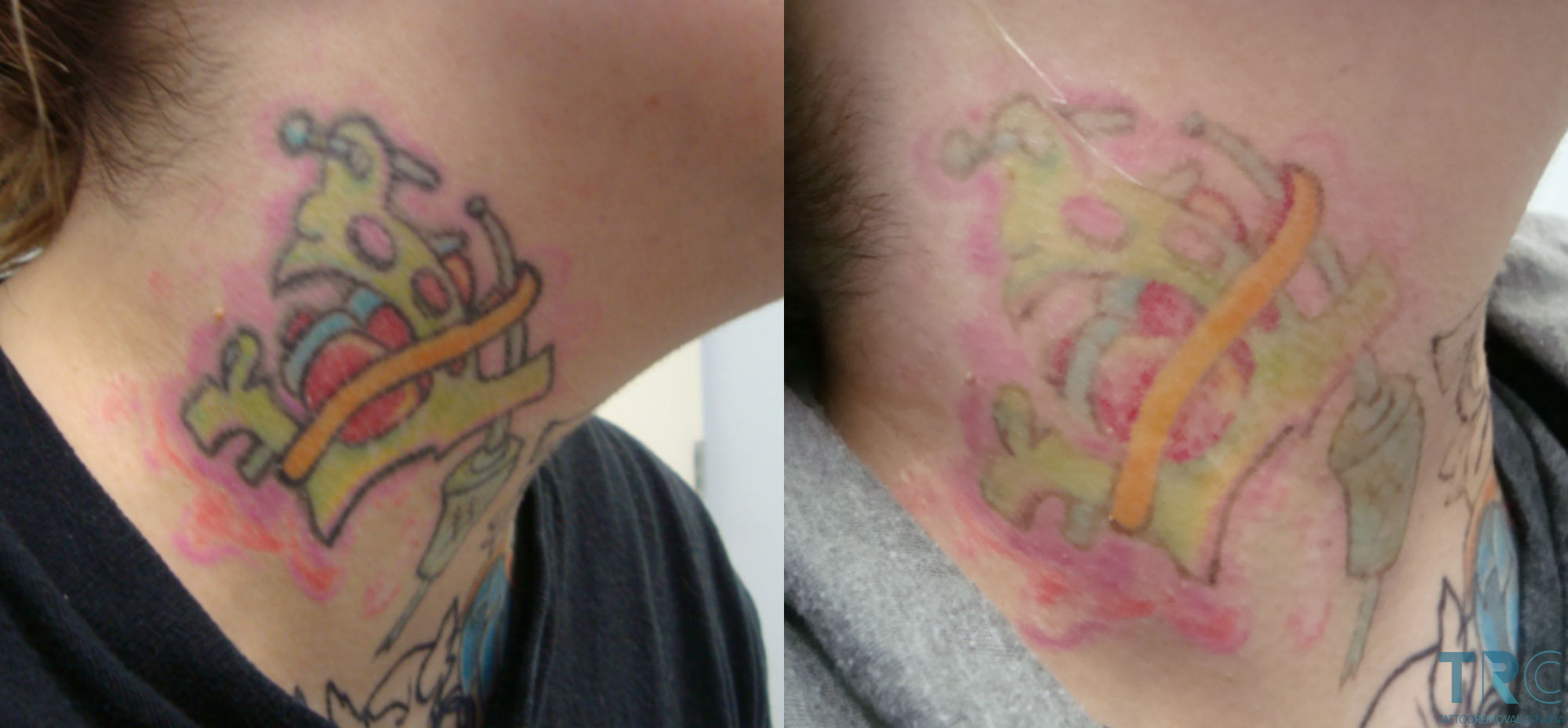
Lasers are colour sensitive. This is a practical example showing how different colours fade at different rates when using tattoo fading lasers. Certain colours fade more than others. As a rule of thumb, with laser tattoo removal the hardest colours to fade are the brightest and especially green. Yellow and brightest colours still evident. The darkest colours have mostly all faded. Also, it is noticeable the colour scattering caused by the laser treatment.
The figure above shows a practical example of laser tattoo fading and it demonstrates what we have said earlier, i.e. different colours fade at different rates. The type of tattoo shown is particularly colourful therefore it may be particularly challenging to fade using lasers. On the left, we can see this colourful tattoo at the beginning of the laser removal treatment. As seen on the right the tattoo has faded only slightly after a few lasers sessions, however, the brightest colours are the most resilient while the darkest ones including red have faded most.
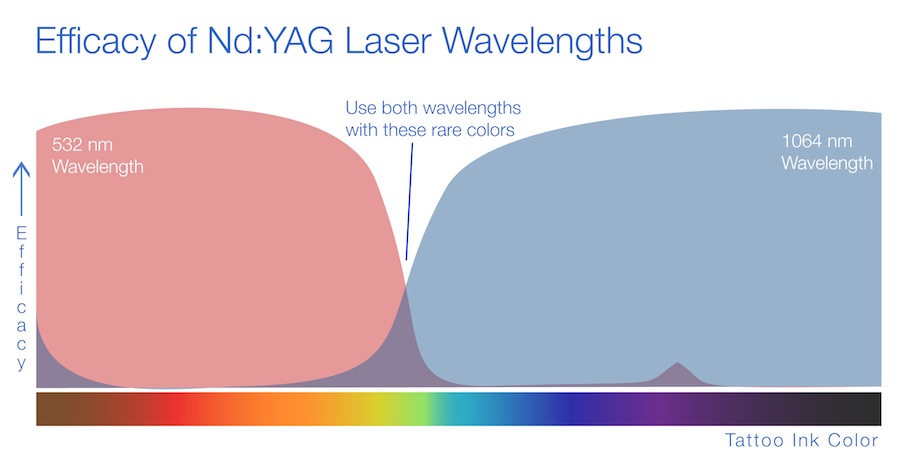
This figure illustrates the efficacy of two wavelengths on laser tattoo fading of certain colours. As we know not all colours fade in the same way after laser treatments. This representative graph shows there is an efficacy drop at the yellow-green colour. As it is well known these are the most difficult colours to be faded using laser tattoo removal.
In particular, the figure above provides an estimation of the efficacy of two particular wavelengths in fading certain tattoo colours. Please bear in mind that this figure is only a rough representation which serves to illustrate the dependency of the wavelength with the efficacy of each specific tattoo colour. However, actual results may vary from the graph above because generally, the efficacy of lasers are good on dark tones despite the wavelength. The purpose of the figure above is to illustrate how the fading efficacy on individual tattoo colour is fundamentally dependent on the wavelength used. Different wavelengths fade pigment colours differently. As we can see from the graph, the hardest colours to fade are green, yellow and the brightest tones in general.
Although there are other tattoo fading treatments which are colour blind, the resilience of green and bright colours have been addressed for years in laser tattoo fading treatments.
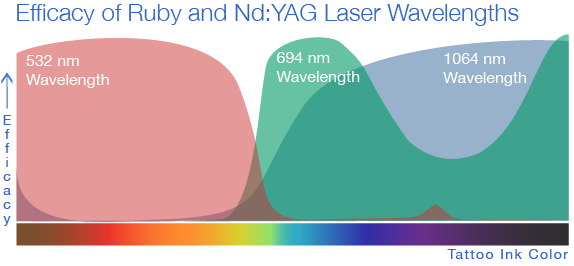
This graph shows an estimation of the efficacy of each wavelength on tattoo individual colours. In order to increase the efficacy of lasers on particularly bright colours and green, other wavelengths have been introduced. This graph, in particular, shows how light radiation at 694nm has an increased efficacy on bright colours and green. Please note that despite the research and the numerous trials to increase the efficacy of fading green and bright pigments they are still challenging using lasers. These colours can be faded using alternative tattoo fading treatments which are not colour sensitive.
Certain colours have proved more difficult to remove than others. In particular, this occurs when the tattoo is treated with an inappropriate wavelength. It has been shown that green ink tattoos somehow respond to treatments with 755 nm light and also to 694nm, 650nm and 1064nm. Some manufacturers have come up with multi-frequency lasers and their treatment intensity levels are particularly high compared to mono-frequency Q-Switched lasers. The result is that often, due to the high intensity of the multi-wavelength laser treatment most of the pigments fade dramatically, however, due to the deeper skin burn caused by the laser, there is usually an increased likelihood of undesired permanent adverse effects like hypo-pigmentation, permanent change in skin texture and permanent scars.

Wavelengths vs absorption coefficient. This logarithmic graph provides further evidence of the colour sensitivity of lasers. A higher absorption coefficient does not necessarily translate in a proportional pigmentation fading rate.
- Q-Switched Alexandrite and Ruby operating at 755 nm and 694 nm. The weakest of all the Q-Switched devices, they generate an orange/red light which is highly absorbed by green and dark tattoo pigments. However, the alexandrite laser colour is slightly less absorbed by melanin, so Alexandrite laser has a slightly lower incidence of unwanted pigmentary changes than a ruby laser. This laser (Alexandrite) was reported to have some moderate effects on green tattoos, but because of its weaker peak power, it works only moderately well on black and blue ink. It does not work at all (or very minimally) on red, orange, yellow, brown, etc. This laser wavelength (755 nm) is also available in picosecond pulses (instead of the ordinary nanosecond) with unverified claims that it removes ink faster.
- Q-switched Nd:YAG: 1064 nm. This laser creates a near-infrared light (invisible to humans) which is also poorly absorbed by melanin, making this the only laser suitable for darker skin. This laser wavelength is also absorbed by all dark tattoo pigments and is the safest wavelength to use on the tissue due to the low melanin absorption and low haemoglobin absorption. This is the wavelength of choice for tattoo removal in darker skin types and for black ink. Dye modules are available for some lasers to convert 532 nm to 650 nm or 585 nm light which allows one laser system to treat multicolour tattoo inks. The role of dye lasers in tattoo removal is discussed in detail in the literature.
As we know tattoo fading lasers are colour sensitive while other tattoo fading treatments which are colours blind. There have been several claims of outstanding effectiveness on all tattoo colours made by certain tattoo fading laser manufacturers, however, the inherent physics of lasers has its own limitations which appear hard to be overcome.
Temporary adverse reactions typical to laser tattoo fading treatments are several, however, these are only transient (temporary). These temporary adverse reactions are:
- Pain caused by the treatment.
- Bleeding which can occur during the treatment itself. This is only minor and it subsides almost immediately on its own accord.
- Frosting. This is typical of tattoo laser treatments only. No other tattoo fading treatments present similar reactions other than cryotherapy, which is seldom used for this application. In the case or cryotherapy, the frosting is caused by the induced freezing of the skin.
- Blistering. Blistering is inevitable after tattoo fading laser treatments, it can only be somewhat minimised performing low-intensity treatments and with the use of potent topical soothing products immediately after the procedure.
- Associated to the blistering is the discomfort during healing. The level of discomfort depends on the intensity of the treatment, the sensitivity of the individual, and whether or not an appropriate soothing product was used. It is indeed the level of discomfort experienced during the treatment and during the days following the treatments associated with the relatively low rate of tattoo fading which sometimes discourage people from undergoing further treatments.
- Transient textural changes are occasionally noted but often resolve within a few months on their own accord; however, permanent textural changes and scarring can also occur. If a client is prone to pigmentary or textural changes, longer treatment intervals are recommended.
- Occasionally, "paradoxical darkening" of a tattoo may occur, when a treated tattoo becomes darker instead of lighter. This occurs most often with white ink, flesh tones, pink, and some cosmetic make-up tattoos.
- A local infection is always possible. The likelihood of this occurrence can be minimised by following the appropriate aftercare, especially avoiding puncturing or bursting the blisters.
- Photoallergic reactions. Local allergic responses to tattoo pigments have been reported. Allergic reactions to tattoo pigment scattering after Q-switched laser treatment are also possible because lasers by mobilizing the ink may trigger a systemic allergic response. Rarely, when yellow cadmium sulfide is used to "brighten" the red or yellow portion of a tattoo, a photoallergic reaction may occur. The reaction is also common with red ink, which may contain cinnabar (mercuric sulphide). Erythema, pruritus, and even inflamed nodules, verrucose papules, or granulomas may present. The reaction is usually confined to the site of the red/yellow ink. Oral antihistamines and anti-inflammatory steroids have been used to treat allergic reactions to tattoo ink also after photoallergic reactions to laser fading treatments.

Laser tattoo fading treatments are inevitably painful. This is caused by the deep burn-induced during the laser treatment.
One of the challenges of laser tattoo fading is the pain and discomfort during the treatment itself. Laser tattoo fading treatments are uncomfortable - many people say laser treatment is worse than getting the tattoo on. While the tattooing soreness is normally bearable, laser tattoo fading treatment is often reported to be unbearable. The pain is often described to be similar to that of hot oil poured on the skin (caused by the deep burn inflicted during the treatment), or a "snap" from an elastic band (caused by the high energy impulse generated by the Q-Switched laser). Depending on the person's individual pain threshold, some people can have the treatment done without using any form of numbing product, while others prefer to undergo the treatment using a topical anaesthetic (numbing cream). Please note that the use of local injectable anaesthetic is not required for this type of treatment because there are appropriate topical over the counter numbing products or effective topical products specially made for this and other aesthetic applications, which normally allow a pain-free treatment. Different numbing products have different efficacy and modality of application (follow the specific manufacturer's instructions). Hence local injectable anaesthetics are not required for this type of aesthetic procedure.
Bleeding is a common immediate consequence of laser tattoo fading treatments. This is because the laser's high power impulses have to cause an ablation inside the dermis in order to be effective. A large number of capillaries are normally present inside the dermis, and the ablating power of the laser at the dermal level has the direct effect of breaking some of those capillaries hence causing some minor immediate bleeding. This is generally a very normal reaction and should not be interpreted as a sign or direct unintended harm caused by the treatments, but as a natural direct consequence of the treatment itself due to its very nature.
The degree of bleeding depends on the wavelengths used, the power level used by the impulsed of the Q-Switching laser and the individual's level of vascularisation of the treated area. Some areas may be more vascularised than others. Non-Q-Switched laser treatments, like CO2 or Argon lasers, which are very rarely offered these days, can rupture blood vessels and aerosolize (vaporise) tissue to such an extent that requires a plastic shield or a cone device to protect the laser operator from tissue and blood contact. Protective eye-wear may be worn if the laser operator chooses to do so.
In any case, the bleeding is only minor, as the vessels broken during the laser treatment are only superficial capillaries. This minor bleeding stops a few minutes after the treatment. Also because of the likelihood of minor bleeding, one the of the recommendation made by the tattoo removal clinics is not take use any aspirin or blood thinning drugs before tattoo fading treatments (just to avoid slightly more prolonged bleeding).
Laser tattoo fading procedures are quite painful, unfortunately, the pain and discomfort do not end there. While, as we have just seen the pain during the treatment is an easily solved problem with the use of appropriate topical numbing products, unfortunately, any laser treatment purposely inflicts a deep burn into the skin in order to fade the tattoo. Because of this skin burn, a direct consequence of every tattoo fading treatment is a fully fledged purposely inflicted burn injury which requires healing time. This burn is merely caused by the physics of the laser itself, although it can be somewhat attenuated, it cannot be avoided by varying the laser functioning parameters, by altering the laser design or modifying the treatment modality.
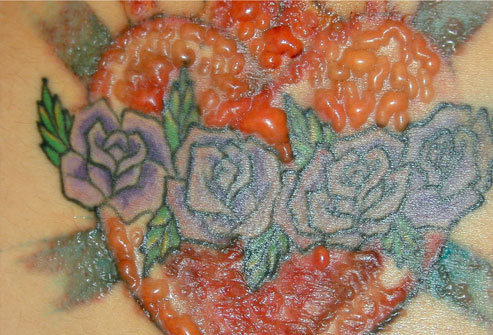
Blistering is a normal reaction to laser tattoo fading treatments. Blistering can be minimised but never completely avoided. This is due to the very nature of the laser tattoo fading treatment which inherently inflicts a burn onto the skin in order to fade the tattoo.
Depending on the area covered by the treatment and the intensity of the treatment, the extent of the skin burn caused by the laser can be significant at times. Having a relatively large and deep skin burn can be a very unpleasant and uncomfortable experience during the healing process. Like most skin burns, the direct effect of the laser tattoo fading treatments is blistering. The discomfort usually peaks when the blistering have fully formed.
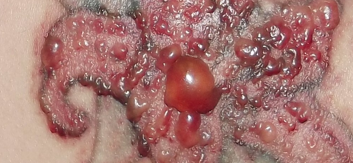
Example of moderate blistering after a mild tattoo laser treatment. The skin reacts to the tattoo fading treatment as it would after any other skin burn. Blistering is one of the ways the skin reacts to deep and intense laser skin burns.
Like any other skin burn, the discomfort lasts as long as the burn is still healing. The discomfort usually starts to subside of its own accord as the blisters heal, however, some degree of discomfort can persist even after the blisters have subsided and the treated tattoo has healed completely. In certain cases, the part may feel tender to the touch and over sensitive for several weeks, even after the blisters have subsided and the part has healed completely.
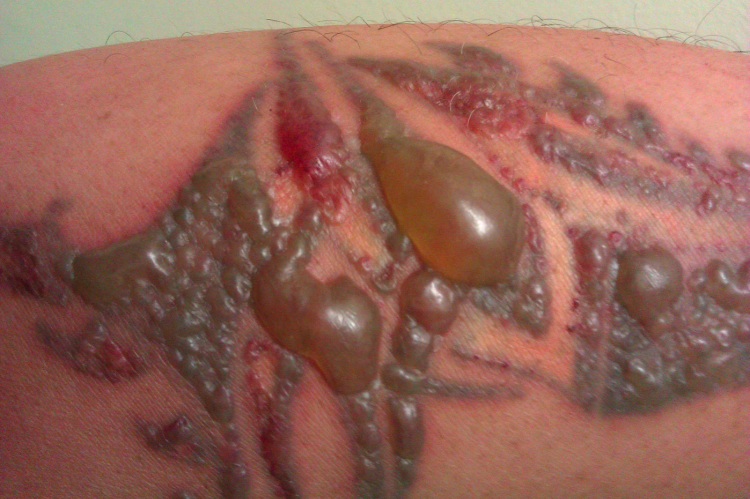
The blisters increase in size proportionately with the laser treatment intensity. The higher the intensity the larger the blisters and the more the discomfort levels experienced during the healing process.
One of the reasons for not treating wide tattoos all at once is to make the clients return for further treatments. The wider the area treated using lasers or the higher the intensity of the treatment, the larger the area subject to the skin burn, the higher the discomfort and pain experienced during the healing process. Additionally causing a skin burn over a relatively large area may have side effects like lethargy and other feverish-like symptoms which physiologically occur after large skin burns.
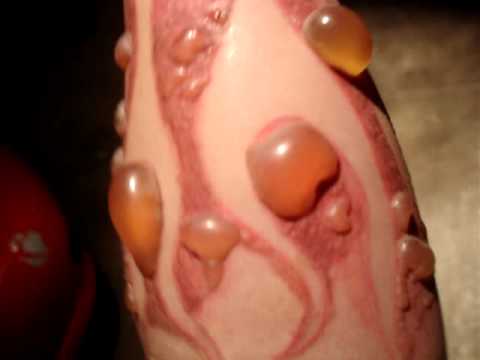
Relatively large blisters caused by a laser high-intensity treatment. The higher the intensity treatment the larger the blisters and the more uncomfortable the healing process.
Very often, the overall unpleasant experience sometimes deters the clients (incorrectly referred to as patients) from undergoing all the treatments required in order to completely remove or close to completely removing the tattoos. Sometimes, due to the discomfort levels, most people prefer to undergo the minimum number of laser tattoo fading treatments required, and then opting for tattoo cover-up as soon as pigmentation has faded enough to make it a feasible option.
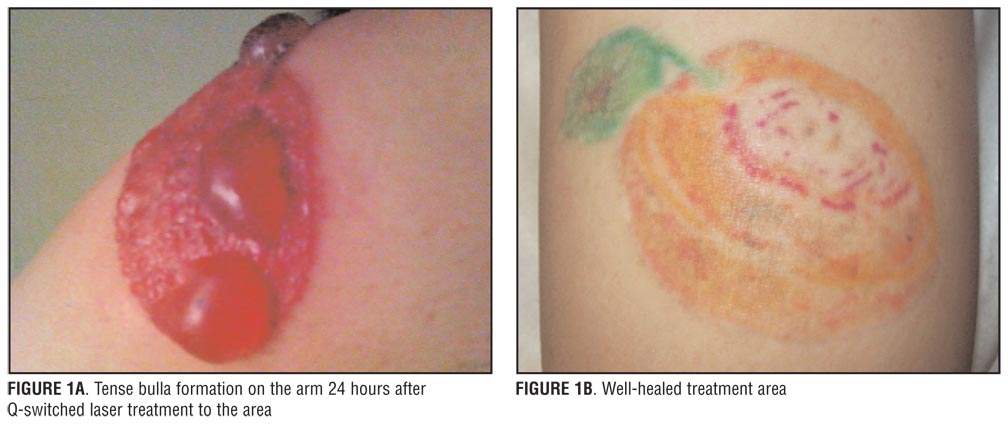
Blistering after lasers treatments can be minimised but never completely avoided due to the inherent physics of the laser tattoo fading treatment.
The amount and size of blistering developed during the healing process depending on the intensity of the laser treatment. The higher the treatment intensity the larger the blisters and the longer it will take for the area to recover, conversely the milder the treatment the smaller the blistering sand the faster the recovery process.
If the burn inflicted by the laser treatment is not too intense the area can heal normally and the tattoo will have faded slightly after the recovery period. In case of very high-intensity treatments the burn inflicted by the laser may as well remove most of all the tattoo pigments, however, the blistering will be very large and the likelihood of permanent adverse effects due to the treatment increases dramatically.
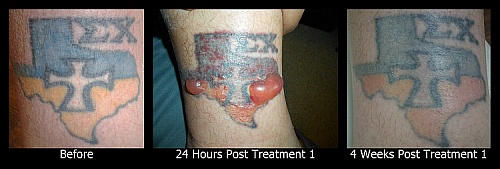
A typical example of before, pictured during the blistering and after the area has recovered from the burn caused by the Laser.
The blisters start to form 24 hours after the treatment, peak two to three days after the treatment and will gradually subside by their own accord.
It is important not to interfere with the healing process of the blisters. In particular, the blisters must not be burst or pierced intentionally to avoid an increased likelihood of infections and other adverse reactions. For more information about the appropriate after-care for the blisters caused by the laser tattoo removal treatment please watch the video below.
Uninformed clients sometimes expect that their unwanted tattoos will be completely removed within one session and with seamless results. This is very rarely possible using lasers tattoo fading treatments. Once the clients are informed about the real results of this type of aesthetic treatment, the first questions they will ask are the number of sessions required and how much it will cost them to achieve the best tattoo fading results. Ultimately, these two questions are inextricably linked. The total cost of the laser removal treatment will be the number of sessions times the cost per session.
No matter what their qualifications or their expertise, no aesthetic practitioner can predict for certain exactly how many sessions it will take to achieve the clients' desired results. Because there are several factors that will determine the number of sessions required. Before a patch testing is carried out, all an experienced tattoo removal practitioner can do is provide an educated estimation. Anyone who claims to provide the exact number of treatments for a complete and seamless tattoo removal is probably trying to sell something based on false promises.
Complete laser tattoo removal often requires numerous treatment sessions, typically spaced at least seven weeks apart. Treating more frequently than seven weeks increases the likelihood of adverse effects and does not necessarily increase the rate of ink absorption. Anecdotal reports of treatments sessions spaced less than seven weeks (four weeks) lead to more scarring and hypo-pigmentation and could increase liability for clinicians (especially in case an appropriate consent form is not in place). At each session, only a fraction of the tattoo pigments is effectively fragmented and faded over the following weeks. Remaining large particles of tattoo pigment are then targeted at subsequent treatment sessions, causing further lightening. The number of sessions and spacing between treatments depends on various parameters, including the area of the body treated and skin colour. Tattoos located on the extremities, such as the ankle, generally take longest. Aesthetic practitioners may recommend that clients wait many months between treatments to facilitate ink resolution and minimise the likelihood of unwanted adverse effects.
In the vast majority of cases, satisfactory results are achieved after several sessions and the results are seldom seamless. In general, the number of sessions required to achieve satisfactory fading results can vary from 6 to 15 depending on several factors. Some tattoos can be particularly easily removed and completely seamless removal can be achieved in one or two sessions (this is generally the case of certain high-quality permanent make up tattoos), however, this is not the norm. Most tattoos can be extremely resilient and it may be even impractical or not advisable to try and achieve complete removal. Some laser tattoo removal manufacturers claim their latest devices remove all tattoos within one session without adverse permanent reactions, these claims are unverified.
While certain tattoos are easily removed in few sessions (especially permanent makeup), despite the claims made by laser manufacturers, there is no evidence that all tattoos can be removed within one treatment without leaving a visible scar, hypo-pigmentation or another type of permanent skin texture change. Seamless complete tattoo removal is more the exception than the norm, especially due to the way tattoos have been originally drawn. In case of particularly resilient tattoo pigments, a certain degree of tattoo fading will be regarded as a good result because complete removal without leaving any scar or permanent skin texture may be unlikely.
So, what are the most important factors in determining the number of sessions especially in laser tattoo fading procedures? Most of the factors have already been covered in details in the general tattoo fading section. it is advisable that you review these points before continuing reading. To review these points please CLICK HERE. Some of the points below are particularly typical to laser tattoo fading treatments only:
- The intensity of the treatments. Like any other type of tattoo fading procedure the higher the intensity of the treatment the more the degree of tattoo fading after each session and therefore the fewer sessions required to achieve satisfactory fading. On the other hand the higher the intensity of the treatment the higher the likelihood of permanent undesired adverse effects like hypo-pigmentation, permanent change in skin texture and scarring. Conversely, the milder the treatment intensity the less the tattoo fades after each treatment and therefore more sessions will be required.
- A number of wavelengths used by the device. This is peculiar to laser tattoo fading treatments only. As we know, lasers are devices that can emit a discrete number of wavelengths at a time (either one, two, three etc). Some manufacturers have devised multi-frequency lasers which can emit a number of different frequencies all at once. This is in an effort to eliminate all or most tattoo colours as quickly as possible. Multi-wavelengths tattoo fading lasers have a generally natural tendency to fade the tattoos more than mono wavelengths frequency lasers. This is because of the more the wavelengths used by the laser, the higher the treatment intensity and the more the tattoo will fade after each session. As the intensity of the treatment increases so inherent likelihood of permanent adverse reactions increases. Conversely, mono wavelengths (or mono-frequency lasers) will fade the tattoo to a lesser extent after each treatment.
- Tattoo colours. As it is well known, unlike other tattoo fading treatments, lasers fade colours at different rates and some colours can be particularly challenging to be faded. Therefore more colourful and bright tattoos are the more challenging they will be and more sessions will be required. Whereas darker tattoos may require fewer treatments to achieve satisfactory fading.
- Skin tone. The darker skin tones are more prone to develop hypo-pigmentation after laser treatments. For this reason, the darker the skin tone the milder the laser treatment is required to be in order to try and avoid this occurrence. Since hypo-pigmentation is the only reason the tune down the intensity of the laser treatment and other types of fading treatments do not usually display this type of adverse reaction, darker skin tones may benefit from other typed of tattoo fading treatments which do not lead to hypo-pigmentation.
Sometimes estimations based only on previous experience can be completely unreliable. The best way to estimate the number of sessions required in order to achieve the desired results is an extrapolation after appreciating the results of a patch test or after the first session. This is because every tattoo is different and there is seldom little background information about the tattoo itself and the way it was originally made.
There are several factors which determine the number of sessions required in order to achieve the desired results. Factors influencing this include skin type, location, colour, amount of ink, scarring or tissue change, tattoo layering etc. Since the number of laser tattoo sessions required to achieve the desired results is a frequently asked question, a predictive scale, the "Kirby-Desai Scale", was developed by Dr Will Kirby and Dr Alpesh Desai, dermatologists with specialization in tattoo removal techniques, to assess the potential success and number of treatments necessary for laser tattoo removal, provided the medical practitioner is using a Q-switched Nd: YAG (neodymium-doped yttrium aluminium garnet) laser incorporating selective photothermolysis (i.e. the use of light produced by lasers to produce heat damage) with six weeks between treatments.
The Kirby-Desai Scale assigns numerical values to six parameters: skin type, location, colour, amount of ink, scarring or tissue change, and layering. Parameter scores are then added to yield a combined score that will show the estimated number of treatments needed for satisfactory tattoo fading. Some recommend that the Kirby-Desai scale is used by all laser practitioners prior to starting tattoo removal treatment to help estimate the number of treatments required for tattoo removal and as a predictor of the success of the laser tattoo removal treatments. Prior to 2009, clinicians had no scientific basis (other than patch testing) by which to estimate the number of treatments needed to remove a tattoo and the use of this scale is now standard practice in laser tattoo removal.
The video below serves to provide an example of the real fading results achievable after mild laser tattoo fading treatments. This video can serve to manage the clients' expectations when first undergoing tattoo fading treatments.
At first sight, most laser tattoo removal advertisements seem to promise seamless total tattoo fading results. Marketers should not be blamed for this initial misconception about laser tattoo removal procedures, because this is what attract people in the first place. Marketing the real results and the real expectations from the laser treatments would not be very effective and could deter people from inquiring about the treatment to start with. Unfortunately, marketing campaigns focusing on the real results are not very effective in the commercial world, especially when at first sight all the major clinics suggest seamless removal results. Therefore the common initial expectation of the uninformed client is the complete and seamless removal of their tattoos within one easy session. However, as we know, this is seldom the reality of laser tattoo removal treatments results as also demonstrated by the terms of business presented prior to the treatments.

Example of common tattoo removal advert. These are designed to capture the audience attention, however, these claims cannot reflect what it is currently possible to accomplish in reality.
As a matter of fact, there are currently no laser tattoo removal devices or techniques which can guarantee consistent seamless results. It is sometimes possible to remove certain types of tattoos using lasers within one or very few sessions, however this is the exception and not the norm; also very high-intensity treatments make tattoo fading possible for most tattoos in very few sessions however this does increase the likelihood of causing intense skin burns which will lead to permanent very visible adverse reactions (mainly scars, hypo-pigmentation and permanent skin texture change).
When the pigments are located too deeply into the dermis or in case of multi-layered tattoos seamless removal may be highly unlikely in any case. This is because the ablation has to be carried out so deeply inside the dermis in order to remove all the pigmentation that the likelihood of permanent adverse reactions is very high. Usually, these types of tattoos can be faded to a certain extent, however complete disappearance is very unlikely. More generally as a rule of thumb, the higher the points on the Kirby-Desai scale the more unlikely a complete seamless removal will be. Conversely, the lower the points the more likely a seamless removal will be. An example of low points tattoo is permanent make-up, usually removed within one or two sessions.
As we know, laser tattoo fading treatments consist in inflicting a skin burn on the tattooed area in order to scatter the colour pigments. The skin does not react well both in the short and long-term to skin burns. Therefore, due to the very nature of this type of aesthetic treatment, seamless results after a complete removal are more the exception than the rule. Aware of the high likelihood of permanent adverse reactions to the laser treatment, very few cosmetic clinics are willing to guarantee seamless results, despite the claims (implicit or explicit) made during the advertising campaigns. This is because experienced aesthetic practitioners are very well aware of the nature of laser treatments as well as what it is to be expected from this type of tattoo fading treatments. The real expected results also emerge in the informed consent forms, which clinics use in order to minimise their potential liabilities due to the permanent real adverse reactions. Often there may be skin texture change which can be permanent, hypo-pigmentation, colour scattering, a trace of the previous pigmentation or the tattoo will not be completely removed as it may be impractical to do so without leaving a scar tissue.
The client should be made aware of what is to be expected from tattoo laser fading treatments. Some of the permanent adverse effects of laser tattoo fading treatments are:
- Hypo-pigmentation. Hypo-pigmentation associated with some sort of skin texture change is the most common permanent long-term adverse effect of burns caused by lasers. It does not usually occur after other tattoo fading treatments. Hypo-pigmentation associated with some sort of skin texture change is the most common permanent long-term adverse effect of burns caused by lasers. The likelihood of hyperpigmentation is exacerbated in dark skin types, and this is the reason for many mild treatments to be used on dark skin tones. Some clinics even prefer to avoid laser treatments on skin type 4, 5 and 6.

Aesthetic cosmetic laser treatment is sometimes avoided on skin types 4, 5 and 6 altogether to due to the likelihood of hypopigmentation. Those clinics which would perform laser treatments on these darker skin tones perform very mild treatments, in order to minimise the likelihood of hypo-pigmentation.
Especially in darker skin tones, the likelihood of hypo-pigmentation is so high that some cosmetic clinics do not suggest laser treatments at all. In case of dark skin, the aesthetic practitioner may still inform the clients of the inherent potential adverse reactions (especially hypo-pigmentation) and if the clients agree they perform the least invasive laser treatment to minimise the risks of hypo-pigmentation even if the number of treatments required to achieve the desired results increases dramatically (sometimes exceeding 2o treatments in case of resilient tattoos). Hypo-pigmentation is very likely to occur especially after intense multi-wavelengths or very high-intensity treatments. It can sometimes be temporary, however, it is mostly permanent. Many people prefer to have hypo-pigmentation rather keeping their unwanted tattoo. Hypo-pigmentation is sometimes resolved with permanent camouflage make-up (another form of tattooing).
- Hyperpigmentation. This can occur because the tattoo fading treatment also triggers skin regeneration. As it is well known, exposure to sunlight without sun protection can cause hyperpigmentation. In certain cases, some light colours such as yellow or white can become dark. This paradoxical darkening can lead to an aesthetic change. These colours can be removed with other laser sessions.
- Permanent skin texture change. This occurs especially after intense laser treatments. Wrinkled appearance or slight effect of depth on the skin in the case of 3D tattoos. This is a common characteristic of laser tattoo fading treatments and can also occur after other types of tattoo fading treatments.
- Can cause scars especially hypertrophic. The likely of hypertrophic scars development is exacerbated by high-intensity treatments using multi-wavelengths lasers. However, the main cause of permanent scarring is poor after-care or predisposition to scarring. This type of adverse reactions can occur after any type of tattoo fading treatments.
- Keloid formation. This can also occur after any other type of tattoo fading treatment.
- Incomplete, even impossible, elimination of all traces of tattoo ink. Polychrome tattoos, in particular, pastel colour, yellow and dense or deep tattoo pigmentation particularly hard to be faded completely. A phantom tattoo (residual traces) can be observed at the end of the course of several treatments.
- Phototoxicity of certain types of tattoo pigments. Some tattoo pigments contain metals that could theoretically break down into toxic chemicals inside the body when exposed to light (including that of lasers). This has not yet been reported in vivo but has been shown in laboratory tests.
The higher the intensity of the treatment the more the tattoo pigmentation is scattered by the treatment, however the more the likelihood of developing adverse permanent adverse reactions due to the deep burn caused by the high-intensity laser treatment. Conversely, the milder the treatment, the milder the burn inflicted, the less the pigmentation scattered and the lower the likelihood of developing permanent adverse reactions after each individual treatment. For this reason, most cosmetic clinics prefer to split the removal treatment into several low-intensity treatments. Not only does this minimise the inherent likelihood of developing adverse reactions but it also increases the overall price of the tattoo fading treatment due to the increased cumulative cost of several sessions.
It has to be reminded that although mild treatments minimise the likelihood of adverse reactions, due to the cumulative skin damages caused by the laser burns also a high number of laser treatments can lead to adverse effects. In other words, because the cumulative damage of several relatively mild laser burns can cause similar adverse permanent reactions to one or few intense laser treatments.
Please note that any permanent adverse reaction can occur regardless of the way the treatment has been performed. Sometimes even one relatively mild laser treatment can trigger one or more adverse reactions. Unfortunately, there is not currently known tattoo fading treatment capable of guaranteeing seamless tattoo removal.
In this section, we can see some real results of laser tattoo fading (removal) procedures. Of course in some cases where the tattoo has a low score in the Kirby-Desai scale the results can be seamless, however, this is not the reality of most tattoo fading treatments, especially those who have a high Kirby-Desai score. The more challenging the tattoo to remove, i.e. the higher the points on the Kirby-Desai scale the more likely the removal of the tattoo pigments will come at the price of some type of adverse reaction. We mainly present those results which display hypo-pigmentation because this is the most common permanent adverse reaction to laser tattoo removal treatments. Not all laser fading procedures will present adverse reactions and some tattoos can be removed seamlessly, however, this is only the case of high-quality tattoos, and those tattoos with a low score of the Kirby-Desai scale.
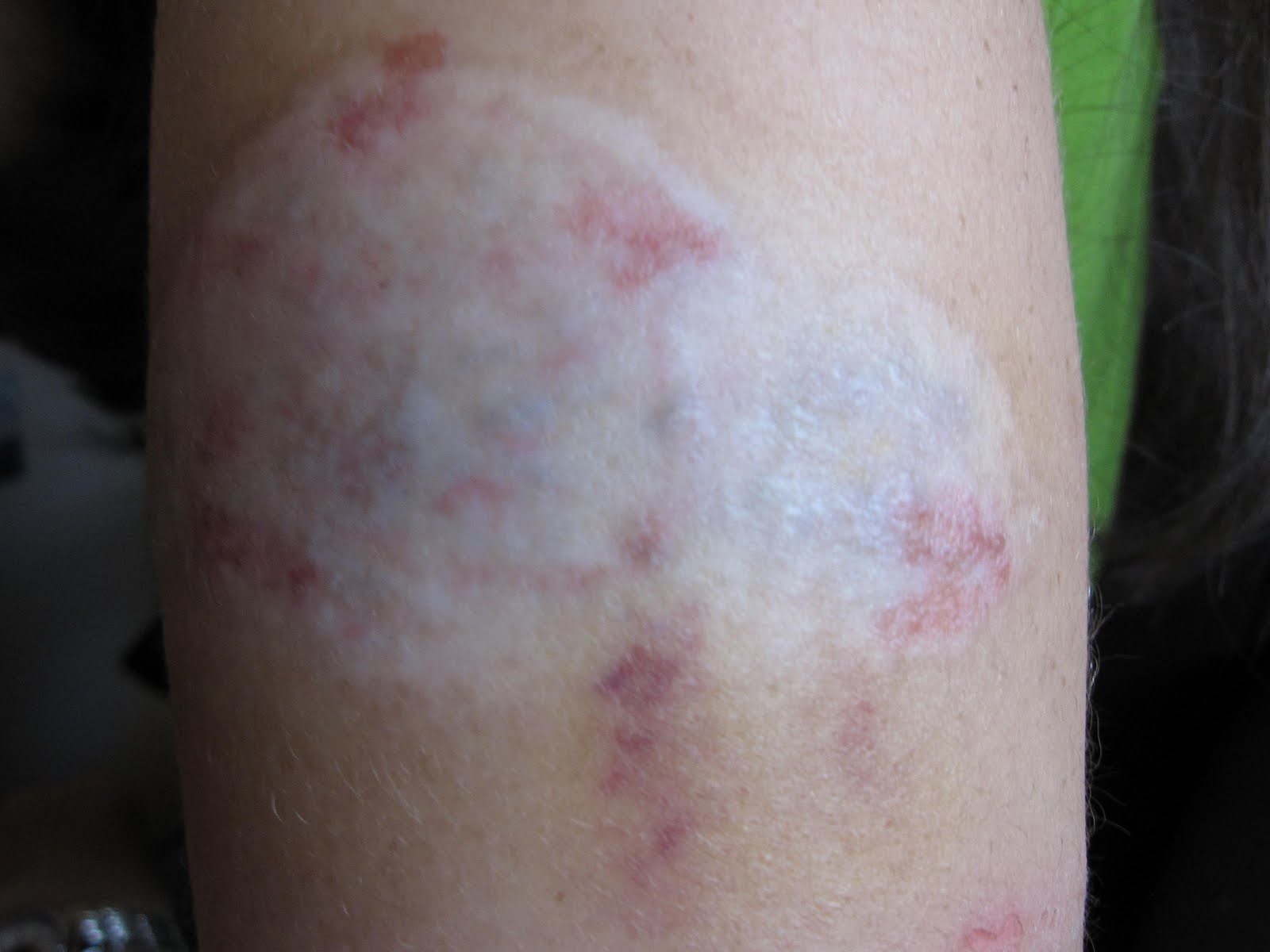
Typical hypo-pigmentation and change in skin texture after intense laser treatment. Hypo-pigmentation is an adverse reaction only peculiar to laser treatments, so far it has not been reported after any other type of tattoo fading treatment.
Hypo-pigmentation is usually permanent however slowly gets better over time. Normal pink hypo-pigmented skin is found after the normal healing of most wounds. The type of permanent hypo-pigmentation caused by laser treatments should not be confused with the normal temporary lack of melanin after a normal wound heal. This is because unfortunately, laser treatments seem to have the inherent tendency of either permanently destroying the melanocytes or somehow permanently inhibit the natural production of melanin.
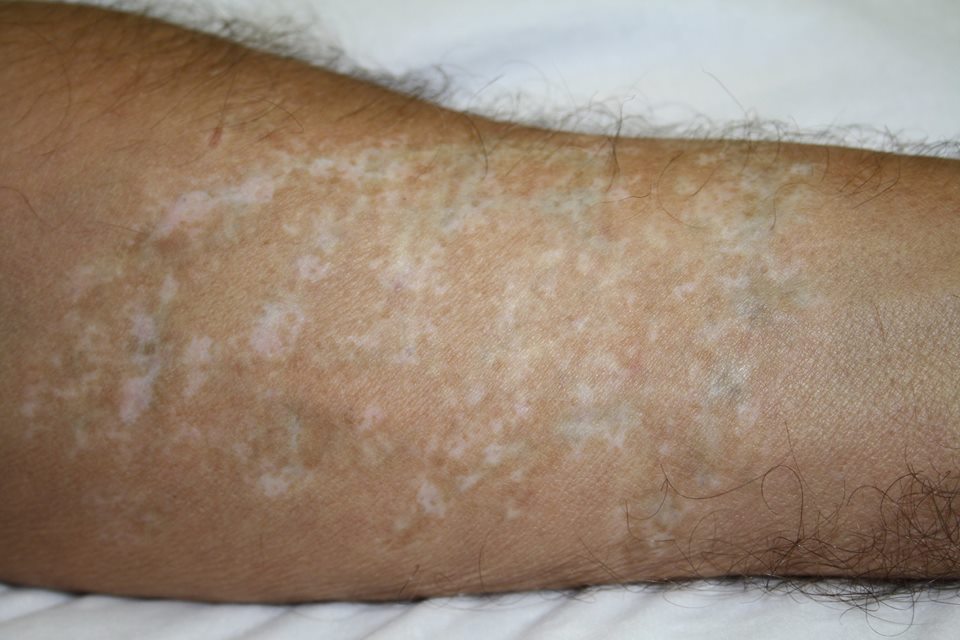
Scattered hypo-pigmentation caused by laser treatment. Typically, this is an inherent risk which can be unavoidable at times. The darker the skin type the higher the likelihood of developing hypo-pigmentation after tattoo laser fading treatments.
As seen in the figure above the lack of melanin can occur in random patches on the area treated by the laser. The higher the intensity of the treatment, the higher the likelihood of this type of adverse effect.
Hypo-pigmentation is more difficult to be removed or attenuated than most other types of adverse reactions to laser tattoo fading treatments. This is because the inherent lack of melanin although can improve slightly over time, is permanent and there are not currently known methods to restore the natural melanin production after it has been inhibited by the laser burn. While hyperpigmentation, scarring, keloids and certain types of skin texture change can be successfully treated in various ways, hypo-pigmentation can improve slightly over time on its own accord but unfortunately, there are not known aesthetic treatments to reverse it. The most common solution to hypo-pigmentation is tattoo cover-up or permanent make-up.
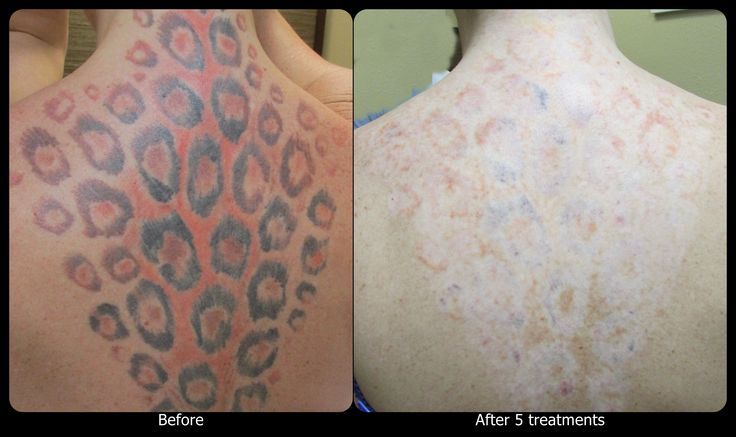
Hypo-pigmentation and variation is skin tone and texture, in general, is a very common permanent skin reaction to laser tattoo treatments. In the figure above we can see how the brightest colours are still present after 5 laser treatments.
Permanent camouflage makeup is a good solution for those areas rarely exposed to the sunlight. Because exposure to the sun will naturally darken the healthy normal skin, while the hypo-pigmented area will not change in colour, therefore exposure to the sunlight and artificial tanning may accentuate the aesthetic problem even after the use of cover-up tattoos or permanent makeup. Therefore tattooing the hypo-pigmented areas with another colour to blend in the hypopigmented area is the most common solution to this adverse reaction.
Due to the high likelihood of change in skin texture, scarring and hypo-pigmentation many people prefer to only fade the tattoo slightly using a laser. They usually only undergo those treatments that fade the most colours
The following experience is brought as an example to show the actual results of laser "tattoo removal" treatments are. As you will see in these three videos the healing process is accompanied by blistering and it is uncomfortable. In third video the "picture" advertised as safe and more effective than common lasers has caused blistering lasting 5 days and possibly due to the high-intensity treatment, the last session left a certain degree of hypo-pigmentation.
We have chosen these videos because they are a true testimony of what clients go through after the laser removal treatments. As you can see in these videos the immediate and temporary normal reactions are those described previously in this web-page (blistering and discomfort).
In this video, you can see the real results of a treatment performed with an expensive heavily advertised tattoo fading/"removal" laser the "picture".
There are several more published videos on the social media and all show similar experiences.
Take the tattoo removal test – Click Here
[:es]
Eliminación de tatuajes con láser. Es muy recomendable leer la sección general sobre eliminación de tatuajes antes de estudiar esta sección centrada en el desvanecimiento de los tatuajes con láser.

Los láseres se han utilizado para esta aplicación estética durante varios años. Los láseres para desvanecimiento de tatuajes son muy fáciles de usar y la intensidad del tratamiento no depende de la forma en que se usa el dispositivo durante el tratamiento en sí. Esto se debe a que, como veremos, la intensidad del tratamiento está determinada en gran medida por la configuración del dispositivo y no por la forma en que se opera el láser. Esto hace que los dispositivos de desvanecimiento de tatuajes con láser sean relativamente fáciles de usar. Hay pocos errores relacionados con la forma en que se usa el láser durante el tratamiento. El único error que se puede cometer es la superposición de los rayos láser que explotan en el tatuaje mientras se opera el dispositivo. Sin embargo, esto se evita muy fácilmente ya que el operador puede apreciar la formación de frosting causada por el láser y evitar tratar nuevamente el área.

Los tratamientos de eliminación de tatuajes con láser son ampliamente publicitados como tratamientos de eliminación de tatuajes. Son el método más popular para eliminar los tatuajes en la mayoría de los países occidentales.
Estos tratamientos estéticos solo duran unos minutos, son fáciles de realizar y el precio por minuto para este tipo de tratamiento es relativamente alto. Por lo tanto muy rentable para las clínicas cosméticas que las realizan. Esto se debe a que la duración del tratamiento en sí es muy breve y el precio que se cobra por el tratamiento es relativamente alto (porque la clientela suele estar muy motivada para que su tatuaje se desvanezca o se elimine). Además, se requieren varios tratamientos para obtener resultados satisfactorios, lo que hace que la cantidad total acumulada cargada sea relativamente alta. Tanto la demanda cada vez mayor como la rentabilidad de estos tratamientos para clínicas han hecho que los tratamientos de desvanecimiento de tatuajes con láser sean el tratamiento estético más popular para esta aplicación.
Los resultados del desvanecimiento son relativamente fáciles de reconocer después de las primeras sesiones, cuando los colores menos resistentes se han desvanecido más. Además, la percepción común de que el uso de los láseres en estética "utiliza la última tecnología de vanguardia", por lo tanto, es segura y efectiva, lo que ha contribuido al aumento de la popularidad de este tipo de tratamiento.
La característica principal de los láseres es su capacidad de emitir una fuente de luz coherente a una frecuencia predeterminada (o longitud de onda). Los láseres también pueden emitir una serie de frecuencias diferentes. La diferencia entre la luz solar, incluyendo la mayoría de las otras fuentes de luz artificial y los láseres, es que los láseres solo pueden emitir luz en longitudes de onda discretas predefinidas. La mayoría de los láseres solo pueden operar a una frecuencia predeterminada en un momento establecido por el operador del láser. Los láseres también están diseñados para emitir un número discreto de frecuencias a la vez (láseres multifrecuencia / longitud de onda). La longitud de onda puede ser una o múltiples, pero un láser nunca puede emitir energía de luz de banda ancha como la mayoría de las otras fuentes de luz artificial y otros dispositivos estéticos (por ejemplo, dispositivos IPL).
Los láseres de frecuencia múltiple también se usan para desvanecer tatuajes y se anuncian como dispositivos de eliminación de tatuajes muy efectivos. Esto se debe a que la combinación de diferentes longitudes de onda puede aportar un mejor desvanecimiento debido a la diferente penetración de cada longitud de onda y el efecto diferente de cada longitud de onda en cada color de tatuaje. Sin embargo, en cualquier caso, la principal diferencia entre los láseres y la mayoría de las otras fuentes de luz natural o artificial es que los láseres, aunque pueden emitir un número diferente de frecuencias a la vez, no pueden emitir luz de banda ancha. Debido a esta peculiaridad de los láseres y la forma diferente en que cada longitud de onda es absorbida por la piel, los láseres tienen una amplia gama de aplicaciones en tratamientos para la piel. Las diferentes longitudes de onda son absorbidas de manera diferente por la piel y la penetración diferente de la piel conduce a resultados diferentes y, por lo tanto, diferentes aplicaciones son estéticas.
La profundidad de la penetración de la luz en la piel está determinada principalmente por la frecuencia emitida. Cuanto mayor sea la frecuencia, más superficial será el efecto del láser en la piel y menos penetrará la luz dentro de la piel. Por el contrario, cuanto menor sea la frecuencia, más profundamente penetrará la luz dentro de la piel.

Esta figura ilustra la forma en que la luz se propaga dentro de la piel. Las longitudes de onda más cortas (azul-verde) solo tienen un efecto de ablación superficial, mientras que las longitudes de onda más largas (rojo e infrarrojo) penetran más profundamente en la piel. Cuanto más alta es la longitud de onda (más baja es la frecuencia) más profunda es la penetración de la longitud de onda específica. Esta es una de las razones de la gran versatilidad de los láseres. Este fenómeno físico permite que los láseres tengan varias aplicaciones en estética, por ejemplo, se utilizan en el rejuvenecimiento de la piel, la depilación permanente, la eliminación de tatuajes, etc. El tipo de tratamiento está determinado principalmente por la frecuencia, la intensidad de la luz y otros factores. Las longitudes de onda anteriores son aquellas que producen los efectos típicos deefecto frosting durante el desvanecimiento de los tatuajes con láser y otros tratamientos estéticos con láser.
La figura de arriba muestra cómo las diferentes longitudes de onda son absorbidas por la piel. En general, cuanto mayor sea la frecuencia (menor longitud de onda), más superficial será el efecto de la luz sobre la piel. Las frecuencias más altas de la energía de la luz tienen una tasa de penetración relativamente baja y su acción es relativamente superficial. Por el contrario, cuanto más baja sea la frecuencia (mayor longitud de onda), más profunda será la penetración de la radiación de luz en la piel. Por lo tanto, para lograr los resultados deseados, se puede utilizar la longitud de onda apropiada para cualquier tipo de resultado estético deseado.
La diferencia en la forma en que cualquier longitud de onda dada se propaga dentro de la piel hace que los láseres sean dispositivos extremadamente útiles y versátiles. Esto se debe a que, en la mayoría de los casos, el usuario puede simplemente cambiar la naturaleza del tratamiento estético variando la longitud de onda del dispositivo junto con otros parámetros. Por ejemplo, para realizar una ablación muy superficial (por ejemplo, eliminar las imperfecciones superficiales de la piel, lunares, marcas de nacimiento, lesiones benignas o realizar una exfoliación de la piel muy superficial), la longitud de onda utilizada es relativamente alta (más de 420 nm / azul o violeta). En estas altas frecuencias, la quemadura, así como los efectos de rejuvenecimiento de la piel, son muy superficiales. Por ejemplo, si los láseres se utilizan para la depilación permanente (depilación permanente), el grado de penetración de la luz requerido es un nivel más profundo (naranja). Esto se debe a que, en la eliminación permanente del vello, el láser debe destruir el folículo piloso enraizado en la dermis. Por lo tanto, la luz láser debe afectar las partes más profundas de la dermis donde reside la raíz del folículo piloso. Por lo tanto, la longitud de onda utilizada es menor (en la región de 600 nm o superior).
En caso de que el tratamiento estético exija un nivel más profundo de penetración, la frecuencia de radiación (luz) se reduce. Aunque los láseres se pueden usar para la depilación permanente, los dispositivos que se usan ampliamente para esta aplicación son IPL.

Aquí, podemos apreciar la principal diferencia entre los láseres (una fuente de luz monocromática o discreta multicromática) y los dispositivos IPL (luz pulsada intensa) que generan una fuente de luz de banda ancha que tiene un nivel múltiple de penetración en la piel. La principal aplicación de los dispositivos IPL es la depilación permanente.
Del mismo modo, en el caso de la renovación cutánea profunda y el estiramiento de la piel con láser, estamos tratando de calentar la dermis para desencadenar la regeneración del colágeno. En estos casos, estamos buscando efectos de penetración profunda, por lo tanto, la longitud de onda elegida puede ser de más de 700 nm (rojo o infrarrojo). Debe quedar muy claro ahora por qué los láseres son tan versátiles que se utilizan en varias aplicaciones para la piel y tratamientos estéticos. Esto se debe a que al variar la longitud de onda emitida junto con otros pocos parámetros, la naturaleza de los tratamientos cambia drásticamente.
Sin embargo, esta es una descripción simplificada de la forma en que la iluminación láser penetra en la piel. Hay varios otros parámetros que juegan un papel en el efecto de la energía de la luz en la piel. Uno de ellos es el diámetro del haz de luz utilizado. En general, cuanto más grande es el diámetro del haz de luz, más profunda es la penetración en la piel, mientras que mientras más pequeño es el diámetro, más superficial es la penetración.

Profundidad del láser relacionada con el diámetro de punto. La profundidad de la penetración de la luz en la piel también está relacionada con el diámetro del haz de luz. En general, cuanto mayor es el diámetro, más profundamente en la piel penetra la luz. Por el contrario, cuanto menor sea el diámetro, más superficial será la penetración. La gráfica de la derecha muestra cómo este fenómeno varía con la longitud de onda utilizada. La línea roja muestra cómo las frecuencias más bajas (1064 nm) pueden penetrar más profundamente al aumentar el diámetro del haz de luz. La línea amarilla (532 nm) muestra cómo cuanto más altas son las frecuencias, tienen un menor grado de aumento de la penetración al tiempo que aumenta el diámetro.
El tamaño del punto, o el ancho del rayo láser, afecta el tratamiento. La luz se dispersa ópticamente en la piel, como los faros de un automóvil en la niebla. Los tamaños de puntos más grandes aumentan ligeramente la profundidad de penetración efectiva de la luz láser, lo que permite un enfoque más efectivo de los pigmentos de tatuaje más profundos. Los tamaños de puntos más grandes también aumentan la intensidad del tratamiento y ayudan a lograr los efectos de desvanecimiento del tatuaje deseados más rápido
Además, el calentamiento de la piel (o el efecto de quemado de la piel) producido por el láser, está relacionado con una serie de parámetros que generalmente no están directamente relacionados con la profundidad de la penetración de la luz del láser. La intensidad del tratamiento del láser se suele calibrar y apreciar de dos formas principales, mediante:
- regulando la intensidad de la emisión de luz así como el impulso del láser mientras se aprecian visualmente los efectos de "frosting" (método utilizado en la mayoría de las aplicaciones estéticas, incluido el desvanecimiento de tatuajes llamado Q-Switching),
- solo ajuste la intensidad y el impulso de la emisión de luz en el dispositivo (esto es típico de los tratamientos con láser de estiramiento profundo de la piel donde los efectos de "frosting" no son visibles). Este es el caso en el que la frecuencia del láser es muy baja, por lo que la penetración de la luz en la piel es tan profunda que no es posible apreciar visualmente el efecto de quemadura del láser.
Este método se basa en variar la intensidad de la emisión de luz y la duración del pulso (ver Q-Switching) mientras se tiene una apreciación visual de los efectos inmediatos de la ablación con láser ("laser frosting"). Es importante darse cuenta de que la intensidad del tratamiento se determina principalmente por el ajuste del dispositivo y la apreciación visual se utiliza principalmente para asegurarse de que los efectos del tratamiento no se vean exacerbados accidentalmente al solapar la ablación con láser. Este método se usa normalmente para la eliminación de lunares benignos, la corrección de imperfecciones de la piel, los tratamientos superficiales de rejuvenecimiento cutáneo con láser y la eliminación de tatuajes con láser. El operador del láser controla los efectos de ablación de dos maneras, tanto al variar la configuración del dispositivo como visualmente al apreciar los Efectos frosting oen la piel.
En el siguiente video se muestra un ejemplo de cómo apreciar visualmente los efectos de ablación inmediatos causados por el tratamiento estético durante el rejuvenecimiento de la piel. El efecto de frosting es inmediato y proporciona al operador una apreciación de la intensidad del tratamiento realizado en el cliente. El usuario puede controlar la intensidad del haz de luz variando las configuraciones del dispositivo láser y teniendo una apreciación visual directa de los efectos inmediatos que el láser tiene en la piel.
Además, otro ejemplo de donde el operador también aprecia visualmente la intensidad del tratamiento durante el tratamiento es la eliminación clásica de lunares con láser. En el vídeo a continuación, podemos apreciar cómo el operador controla directamente el tratamiento repitiendo la ablación con láser durante el procedimiento de remoción de lunares.
Por otro lado, cuando se requiere que la ablación con láser o el efecto de calentamiento se realicen profundamente en la piel, el operador no tiene forma de apreciar visualmente los efectos inmediatos de ablación (quemadura) en la piel. Por ejemplo, en el estiramiento profundo de la piel con láser, los efectos del tratamiento de la piel no son visibles de inmediato (con la formación de escarcha u otras reacciones cutáneas visibles inmediatas), por lo que el tratamiento debe calibrarse solo de acuerdo con la experiencia previa.
La intensidad del tratamiento se determina ajustando la intensidad de la luz y la duración del pulso del láser. Cuanto más larga sea la duración del pulso del láser, mayor será la intensidad del tratamiento, a la inversa, cuanto más corto sea el pulso, menor será la intensidad del tratamiento. En estos tipos de tratamientos cutáneos con láser, los efectos del tratamiento (enrojecimiento e hinchazón) solo se hacen visibles uno o dos días después del procedimiento estético. En estos casos, la intensidad del tratamiento solo está predeterminada al calibrar ciertos ajustes del propio dispositivo láser.
Como ejemplo de baja frecuencia y penetración profunda, el tratamiento es el uso de un láser profundo para el rejuvenecimiento de la piel. En el video a continuación podemos ver un ejemplo de tratamiento de estiramiento de piel con láser profundo. Este es un ejemplo típico cuando la intensidad del tratamiento se establece mediante la regulación de ciertos parámetros y no hay una apreciación inmediata directa de los efectos del láser en la piel.
La eliminación de tatuajes con láser o, más apropiadamente, el trabajo de "desvanecimiento del tatuaje" con láser causan una quemadura controlada en la piel para atenuar los pigmentos del tatuaje. Como sabemos, los pigmentos del tatuaje se encuentran dentro de la dermis.. Por lo tanto, para desvanecer los tatuajes estéticos usando láseres o cualquier otro método, se requerirá inevitablemente un grado de ablación dérmica.

Como hemos visto anteriormente, los pigmentos de los tatuajes se encuentran dentro de la dermis (para obtener más información, haga click aquí). Por lo tanto, para alcanzar los pigmentos del tatuaje y desvanecer el tatuaje, será necesario un grado de ablación dérmica, independientemente del método utilizado para desvanecer el tatuaje, incluidos los tratamientos con láser.
Si está familiarizado con el rejuvenecimiento cutáneo con láser superficial y los principios básicos del estiramiento de piel localizada con láser, notará las similitudes con los procedimientos de eliminación de tatuajes con láser. Al igual que en el rejuvenecimiento de piel con láser y el estiramiento cutáneo con láser, el láser causa una quemadura en la piel intencional. La principal diferencia en el desvanecimiento del tatuaje es que el dispositivo láser se calibra de una forma ligeramente diferente y, en general, la intensidad del tratamiento es más alta que la del rejuvenecimiento cutáneo con láser normal.
En el rejuvenecimiento cutáneo con láser (o el estiramiento cutáneo con láser) el láser tiene que calentar la dermis, el mismo principio se aplica al desvanecimiento del tatuaje con láser. Es el calor (o quemadura) causado por la luz del láser lo que desencadena el resurgimiento y el estiramiento de la piel. De manera similar, el tratamiento con láser acelera la absorción de los pigmentos del tatuaje en etapas, tanto al descomponer algunos pigmentos como al desencadenar la regeneración de la piel causada por la quemadura dérmica causada por el láser.

La física que se aplica al rejuvenecimiento cutáneo con láser también se aplica al desvanecimiento de los tatuajes con láser. Como vemos en esta representación simplificada del rejuvenecimiento cutáneo con láser, la luz del láser penetra en la dermis. Es el calor (o quemadura) causado por la luz láser que desencadena la regeneración de la piel y el estiramiento de la piel.
Al igual que el estiramiento cutáneo con láser, durante el tratamiento de desvanecimiento del tatuaje, el láser causa una ablación dérmica que desencadena el proceso de regeneración cutánea dérmica, y también dispersa parcialmente los pigmentos del tatuaje. Después de cada tratamiento, parte del pigmento tiende a ser reabsorbido por el sistema inmunológico. Algunos fabricantes anuncian ablación selectiva (quemadura) dirigida a los pigmentos del tatuaje, sin embargo, en cualquier caso, la energía del láser es absorbida por la piel en su totalidad y no solo por los pigmentos del tatuaje. Esto se demuestra por el hecho de que la quemadura de la piel se genera en cualquier lugar donde se aplica la luz láser y no solo en el área tatuada. En caso de desvanecimiento del tatuaje con láser, la quemadura de la piel se generaliza en el área tratada, como lo demuestra la formación de ampollas que se forma uno o dos días después de la ablación con láser. Desafortunadamente, actualmente no existe un tratamiento conocido de eliminación de tatuajes o desvanecimiento de tatuajes que pueda atacar selectivamente los pigmentos de los tatuajes durante los tratamientos con láser. En otras palabras, no hay un tratamiento estético capaz de destruir selectivamente los pigmentos del tatuaje solo sin afectar también a la dermis de una forma u otra.

Esta figura ilustra el principio básico del desvanecimiento de los tatuajes con láser. Este es un modelo simplificado para ilustrar el principio de funcionamiento básico del desvanecimiento de tatuajes con láser. Parte de la luz es absorbida por los pigmentos de los tatuajes y se descomponen parcialmente. La tinta dispersada es absorbida por el sistema inmunológico. El láser no puede descomponer toda la tinta del tatuaje durante el tratamiento, solo una parte del tatuaje se absorbe después de cada sesión.
La figura a continuación es otra representación simplificada del proceso de desvanecimiento del tatuaje con láser, ya que no todas las longitudes de onda son absorbidas por la dermis a la misma profundidad y de la misma manera. Los láseres solo pueden emitir un número discreto (finito) de longitudes de onda y cada longitud de onda se absorbe de manera diferente por la piel.. Cuanto más profundos sean los pigmentos de los tatuajes, más difícil será romperlos sin causar algún daño térmico permanente a la dermis (por lo tanto, efectos adversos permanentes). Esto se debe a que, en el caso de una pigmentación muy profunda, la mayor parte de la energía del láser es absorbida por la epidermis y la parte superior de la dermis y solo los pigmentos de los tatuajes absorben una pequeña proporción de luz. Solo las longitudes de onda roja e infrarroja pueden alcanzar la parte inferior de la dermis, sin embargo, incluso su energía será parcialmente absorbida por la dermis superior y solo una fracción de ella alcanzará la dermis más profunda y, por lo tanto, los pigmentos profundos. Normalmente, estas longitudes de onda (roja e infrarroja) se utilizan para el rejuvenecimiento cutáneo con láser profundo, el estiramiento de la piel con láser y la depilación permanente.

Esta es otra representación del desvanecimiento del tatuaje con láser o el rejuvenecimiento cutáneo con láser. También nos referimos a este proceso como rejuvenecimiento cutáneo con láser y esta es también una representación de la forma en que la luz del láser penetra en la piel para el rejuvenecimiento cutáneo con láser y el estiramiento cutáneo con láser. A la izquierda, podemos ver los pigmentos del tatuaje, en el medio, una representación simplificada del tratamiento de desvanecimiento del tatuaje con láser. A la derecha, podemos ver una representación de los pigmentos "dispersos". Esta es una representación sobre simplificada también porque, como sabemos, los láseres rara vez pueden dispersar todos los pigmentos del tatuaje en una sesión, especialmente si los pigmentos se encuentran particularmente profundamente dentro de la dermis.
A continuación tenemos otra representación de la fragmentación de pigmentos de tatuajes con láser. Una vez más, esta es otra representación simplificada de la fragmentación completa de todos los tatuajes que generalmente no es realista en una sesión. Como ya sabemos, solo una parte del tatuaje está fragmentada y absorbida ligeramente. Por lo tanto, no todos los pigmentos del tatuaje se reabsorben después de un procedimiento de desvanecimiento del tatuaje. Además, no todas las longitudes de onda son absorbidas por los pigmentos del tatuaje, y el desvanecimiento del tatuaje depende principalmente del efecto de rejuvenecimiento de la piel para acelerar el proceso de absorción natural. Además, algunos colores de pigmentos de tatuajes no absorben fácilmente una longitud de onda del láser en particular,, por lo tanto, son difíciles de desvanecer con los tratamientos con láser.
En la imagen de abajo, los pigmentos de los tatuajes están representados de manera uniforme en la parte superior de la dermis. Esta es una representación simplificada de la distribución de pigmentos de tatuajes. Los pigmentos del tatuaje rara vez se distribuyen uniformemente dentro de la dermis a la misma profundidad. En realidad, a menudo se encuentran y se distribuyen a diferentes profundidades dentro de la dermis. Alguna parte del tatuaje puede tener una distribución de pigmentos más profunda o menos profunda según la forma en que se dibujó el tatuaje en ese momento y el tipo de pigmentos utilizados.

Representación simplificada de la dispersión de la pigmentación láser. Rara vez todos los pigmentos se dispersan a la vez. Aunque esto es poco frecuente, puede ocurrir en el caso de la decoloración de los colores oscuros y en los tatuajes de alta calidad como el maquillaje permanente. Además, la distribución de los pigmentos del tatuaje rara vez es uniforme y puede ser desigual. Además, tenga en cuenta que esta es una representación demasiado simplificada de la forma en que los tratamientos con láser funcionan para la eliminación de tatuajes. No solo los pigmentos del tatuaje se ven afectados por el láser, sino que también la piel sufre un cierto grado de quemadura causada por el tratamiento con láser.
El principio básico del desvanecimiento de los tatuajes con láser es que el rejuvenecimiento profundo de la piel causado por el láser obliga a que algunos de los pigmentos sean reabsorbidos por el sistema inmunológico. Esta absorción de la pigmentación es un efecto natural que se produce independientemente del tiempo. La intensa quemadura profunda causada por el láser acelera la pigmentación natural del tatuaje, que se desvanece. . Sin embargo, como se vio anteriormente, este proceso se acelera mediante el desvanecimiento del tatuaje en general y, en particular, el desvanecimiento del tatuaje con láser.
Los tratamientos de desvanecimiento con láser de tatuaje son un ejemplo de donde la intensidad del tratamiento en general se determina principalmente al variar la configuración del dispositivo láser. Aunque el usuario puede aumentar intencionalmente la quemadura causada por la superposición de los puntos de ablación mientras realiza el tratamiento, la intensidad general está determinada generalmente por la configuración del dispositivo. Esto se hace controlando la emisión de luz mediante pulsos muy cortos (Q-Switching). Esta es una de las razones de la sensación de ser "golpeado por una banda elástica fuerte" experimentada por aquellos que se someten a tratamientos de desvanecimiento por láser.
El principio principal del funcionamiento de los láseres de desvanecimiento de tatuajes se representa en la figura a continuación. Estos dispositivos láser utilizan el método ¨Q-Switching¨para generar un pulso de luz coherente extremadamente corto pero muy intenso (generalmente en el orden de nanosegundos). Este impulso de luz suele ser de varios órdenes de magnitud mayor en intensidad que los láseres que generan una salida constante.

El Q-Switching es el arreglo láser más utilizado para la eliminación de tatuajes. Como se ve en la figura, la potencia es extremadamente alta para una duración muy corta (nano segundos). Esto garantiza que la intensidad del tratamiento se determina principalmente por la forma en que el usuario configura el dispositivo y no por la forma en que se usa la pieza de mano durante el tratamiento. El ancho del pulso o la duración del pulso es un parámetro crítico del láser. Todos los láseres de Q-Switching tienen una duración de pulso adecuada para la eliminación de tatuajes.
Mientras utiliza el láser Q-Switching una vez que el usuario ha configurado el láser de desvanecimiento del tatuaje, el operador solo necesita asegurarse de que los puntos no se superpongan para no duplicar involuntariamente la quemadura infligida en la misma área. Sin embargo, esto es bastante fácil de evitar, ya que cada vez que la luz incide en la piel deja una clara mancha de "frosting". De esta manera, la intensidad del tratamiento con láser se controla principalmente mediante el ajuste del dispositivo y hay un margen mínimo de error durante el tratamiento en sí.
En el video a continuación, podemos ver un ejemplo de un láser Q-Switchedclásico para el tratamiento de desvanecimiento de tatuajes. Como podemos ver, existe la característica habitual del frosting del desvanecimiento del tatuaje con láser. Esta reacción inmediata a la quemadura infligida a la piel causada por todos los dispositivos de desvanecimiento de tatuajes con láser.
Como hemos visto, el principio fundamental de funcionamiento de los dispositivos de desvanecimiento de tatuajes es Q-Switching. Como podemos ver en la siguiente figura, hay varios tipos de dispositivos Q-Switching que se usan para desvanecer tatuajes, los láseres se pueden hacer para usar Ruby, Alexandrite, YAG o KTP. El material utilizado en el núcleo del láser solo tiene el efecto de determinar la frecuencia operativa principal del láser Q-Switched. Como veremos, una de las principales desventajas del desvanecimiento del tatuaje con láser es el hecho de que las lentes no pueden desvanecer todos los colores de la misma manera. Algunos colores casi no pueden ser prácticos para ser descoloridos por los láseres (especialmente ciertos tonos verdes y pigmentos muy brillantes).

En esta tabla, podemos ver las cuatro frecuencias principales utilizadas en los dispositivos de desvanecimiento de tatuajes. Todos los dispositivos de desvanecimiento de tatuajes utilizan el método Q-Switching. Algunas frecuencias pueden apuntar solo a algunos colores de tatuajes.. A la derecha, podemos ver los tipos de colores a los que apunta cada frecuencia..
Algunos láseres de desvanecimiento de tatuajes se anuncian como capaces de eliminar todos los colores y en un solo tratamiento. Estos son láseres que combinan más de una longitud de onda. Los láseres de eliminación de tatuajes todo en uno más comunes combinan las cuatro frecuencias que se ven en la tabla de arriba. Sin embargo, a pesar de las afirmaciones de los fabricantes, desafortunadamente, el tratamiento de desvanecimiento de tatuajes con láser es fundamentalmente selectivo de color.. Esto significa que algunos colores se desvanecen más que otros. La mayoría de los otros tratamientos de eliminación de tatuajes son ciegos al color, lo que significa que desvanecen todos los colores de manera indiscriminada. Algunos láseres más recientes se anuncian para producir un pulso de alta intensidad que dura unos pocos picosegundos, sin embargo, no se ha realizado ninguna investigación independiente sobre la forma en que funcionan, su eficacia real y las afirmaciones de los fabricantes no se han verificado.
Como hemos visto, la mayoría de los tratamientos de desvanecimiento de tatuajes, aparte de los dispositivos de desvanecimiento de tatuajes con láser, son ciegos al color. Color ciego significa que estos tratamientos tienden a desvanecer todos los pigmentos del color del tatuaje de manera indiscriminada.
Desafortunadamente, en caso de desvanecimiento del tatuaje con láser, los diferentes colores del tatuaje se desvanecen a diferentes velocidades. Algunos colores no se absorben fácilmente y no se desvanecen significativamente después de los tratamientos con láser, especialmente ciertos tonos de verde como los colores brillantes.

La absorción de luz relativa de cada color de tatuaje depende de la longitud de onda específica de la luz que incide en el pigmento. La gráfica muestra la absorción relativa de cada color fundamental en comparación con la longitud de onda.
El gráfico anterior muestra una estimación del grado de absorción de luz relativa de los pigmentos del tatuaje en cada longitud de onda. Esto no debe confundirse con la cantidad de pigmento que se desvanece después de cada sesión de tatuaje. Esto se debe a que, aunque la radiación de la luz puede ser absorbida por los pigmentos particulares, esto no necesariamente se traduce en un desvanecimiento proporcional de los pigmentos de color específicos.

La figura es una simplificación excesiva de la efectividad real del desvanecimiento del color del tatuaje debido al tratamiento con láser. Los colores más oscuros son los más fáciles de desvanecer usando láseres.
El gráfico anterior sirve para mostrar el hecho de que la física inherente de la absorción de luz de los pigmentos del tatuaje hace que el resultado del tratamiento con láser sea inherentemente dependiente tanto de la longitud de onda utilizada como de los colores del tatuaje.
La figura de la izquierda tiene la intención de proporcionar una idea aproximada de los desafíos que enfrenta la atenuación de ciertos colores en comparación con otros que utilizan láseres de atenuación de tatuajes. Como podemos ver, el color verde ni siquiera se menciona en este cuadro representativo. Esto se debe a que, como es bien sabido en la industria, los láseres tienen poco o ningún impacto en los colores verdes del tatuaje. Esto no se aplica a todos los tratamientos de desvanecimiento de tatuajes, de hecho, esta limitación solo se aplica al desvanecimiento de tatuajes con láser. Debido a la naturaleza misma de los láseres, desafortunadamente, ciertas longitudes de onda son más efectivas en ciertos colores de tatuajes y no pueden atenuar otros. Los colores de los pigmentos para tatuar más fáciles de desvanecer son los negros u oscuros en general, mientras que los tonos brillantes y particularmente ciertos tonos de pigmentos verdes son los más difíciles de desvanecer. Por lo general, cuanto más brillantes son los colores, más difíciles son de atenuar el uso de láseres; a la inversa, cuanto más oscuros son, más fáciles son de atenuar el uso de láseres A veces, los colores verdes y brillantes serán mucho más fáciles de cubrir o eliminar utilizando otros tratamientos en lugar de persistir en el uso de tratamientos de desvanecimiento por láser, que pueden tener efectos adversos permanentes..

Esta figura se usa solo para ilustrar qué colores son los más fáciles y los más difíciles de desvanecer usando láseres. (A) representa el tatuaje inicial, (B) el desvanecimiento inicial del tatuaje después de unas pocas sesiones, (C) los resultados después de varias sesiones (donde quedan los colores verde y brillante), (D) el color más difícil de desvanecer Generalmente se deja el último. El verde es el color más desafiante para desvanecerse con láser.
La figura de arriba ilustra cómo los primeros colores que se desvanecen son los tonos negros y oscuros. Como vemos en B, los colores más fáciles de atenuar son los más oscuros, los más brillantes generalmente se dejan después de los primeros tratamientos. En C (después de otros tratamientos de desvanecimiento de tatuajes) los colores que quedan son los más brillantes y verdes. Por último, como se ve en D, normalmente el color verde es el pigmento de tatuaje más resistente con la eliminación de tatuajes con láser. El color verde es tan resistente a los láseres que a veces se considera que no se desvanece con el uso de láseres. Sin embargo, hay fabricantes que afirman que sus nuevos dispositivos son capaces de desvanecerse y que todos los tonos son de colores verdes de manera indiscriminada. Estas reclamaciones no han sido verificadas independientemente.

Los láseres son sensibles al color. Este es un ejemplo práctico que muestra cómo los diferentes colores se desvanecen a diferentes ritmos cuando se usan láseres de atenuación de tatuajes. Ciertos colores se desvanecen más que otros. Como regla general, con la eliminación de tatuajes con láser, los colores más duros para desvanecerse son los más brillantes y especialmente los verdes. Los colores amarillos y más brillantes siguen siendo evidentes. Los colores más oscuros se han desvanecido en su mayoría. Además, es notable la dispersión de color causada por el tratamiento con láser.
La figura anterior muestra un ejemplo práctico de desvanecimiento de tatuajes con láser y demuestra lo que hemos dicho anteriormente, es decir, diferentes colores se desvanecen a diferentes velocidades. El tipo de tatuaje que se muestra es particularmente colorido, por lo que puede ser particularmente difícil desvanecerse usando láseres. A la izquierda, podemos ver este colorido tatuaje al comienzo del tratamiento de remoción con láser. Como se ve a la derecha, el tatuaje se ha desvanecido solo un poco después de algunas sesiones de láseres, sin embargo, los colores más brillantes son los más resistentes, mientras que los más oscuros incluyen los más oscuros.

Esta figura ilustra la eficacia de dos longitudes de onda en el desvanecimiento de tatuajes con láser de ciertos colores. Como sabemos, no todos los colores se desvanecen de la misma manera después de los tratamientos con láser. Este gráfico representativo muestra que hay una caída de eficacia en el color amarillo-verde. Como es bien sabido, estos son los colores más difíciles de desvanecer con la eliminación de tatuajes con láser.
En particular, la figura anterior proporciona una estimación de la eficacia de dos longitudes de onda particulares para atenuar ciertos colores de tatuajes. Tenga en cuenta que esta figura es solo una representación aproximada que sirve para ilustrar la dependencia de la longitud de onda con la eficacia de cada color de tatuaje específico. Sin embargo, los resultados reales pueden variar del gráfico anterior porque, en general, la eficacia de los láseres es buena en tonos oscuros a pesar de la longitud de onda. El propósito de la figura anterior es ilustrar cómo la eficacia de desvanecimiento en el color del tatuaje individual depende fundamentalmente de la longitud de onda utilizada. Diferentes longitudes de onda difuminan los pigmentos de manera diferente. Como podemos ver en el gráfico, los colores más difíciles de desvanecer son el verde, el amarillo y los tonos más brillantes en general.
Aunque existen otros tratamientos de atenuación de tatuajes que son ciegos al color, la resistencia de los colores verde y brillante se han abordado durante años en los tratamientos de atenuación de tatuajes con láser.

Este gráfico muestra una estimación de la eficacia de cada longitud de onda en colores de tatuajes individuales. Para aumentar la eficacia de los láseres en colores particularmente brillantes y verdes, se han introducido otras longitudes de onda. Este gráfico, en particular, muestra cómo la radiación de luz a 694 nm tiene una mayor eficacia en colores brillantes y verdes. Tenga en cuenta que a pesar de la investigación y los numerosos ensayos para aumentar la eficacia del desvanecimiento de los pigmentos verdes y brillantes, todavía son un desafío usar láseres. Estos colores pueden desvanecerse utilizando tratamientos alternativos de desvanecimiento de tatuajes que no son sensibles al color.
Ciertos colores han demostrado ser más difíciles de eliminar que otros. En particular, esto ocurre cuando el tatuaje se trata con una longitud de onda inadecuada. Se ha demostrado que los tatuajes de tinta verde responden de alguna manera a los tratamientos con luz de 755 nm y también a 694 nm, 650 nm y 1064 nm. Algunos fabricantes han creado láseres multifrecuencia y sus niveles de intensidad de tratamiento son particularmente altos en comparación con los láseres Q-Switched de monofrecuencia. El resultado es que a menudo, debido a la alta intensidad del tratamiento con láser de longitud de onda múltiple, la mayoría de los pigmentos se desvanecen dramáticamente, sin embargo, debido a la mayor quemadura de la piel causada por el láser, generalmente existe una mayor probabilidad de efectos adversos permanentes no deseados como Hipopigmentación, cambio permanente en la textura de la piel y cicatrices permanentes.

Longitudes de onda vs coeficiente de absorción. Este gráfico logarítmico proporciona evidencia adicional de la sensibilidad del color de los láseres. Un mayor coeficiente de absorción no se traduce necesariamente en una tasa de desvanecimiento de pigmentación proporcional.
- Alexandrite y rubí Q-Switched operando a 755 nm y 694 nm. El más débil de todos los dispositivos Q-Switched, generan una luz naranja / roja que es altamente absorbida por los pigmentos de tatuaje verde y oscuro. Sin embargo, el color del láser de alejandrita es ligeramente menos absorbido por la melanina, por lo que el láser de alejandrita tiene una incidencia ligeramente menor de cambios pigmentarios no deseados que un láser de rubí. Se informó que este láser (alejandrita) tiene algunos efectos moderados en los tatuajes verdes, pero debido a su potencia de pico más débil, funciona moderadamente bien con tinta azul y negra. No funciona en absoluto (o de manera mínima) en rojo, naranja, amarillo, marrón, etc. Esta longitud de onda del láser (755 nm) también está disponible en pulsos de picosegundos (en lugar del nanosegundo normal) con declaraciones no verificadas de que elimina la tinta más rápido .
- Q-switch Nd: YAG: 1064 nm. Este láser crea una luz infrarroja cercana (invisible para los humanos) que también es mal absorbida por la melanina, por lo que es el único láser adecuado para la piel más oscura. Esta longitud de onda del láser también es absorbida por todos los pigmentos oscuros del tatuaje y es la longitud de onda más segura para usar en el tejido debido a la baja absorción de melanina y la baja absorción de hemoglobina. Esta es la longitud de onda de elección para la eliminación de tatuajes en tipos de piel más oscura y para tinta negra. Los módulos de tinte están disponibles para algunos láseres para convertir 532 nm a 650 nm o 585 nm de luz, lo que permite que un sistema de láser trate tintas de tatuajes multicolores. El papel de los láseres de tinte en la eliminación de tatuajes se discute en detalle en la literatura.Q-switch Nd: YAG: 1064 nm. Este láser crea una luz infrarroja cercana (invisible para los humanos) que también es mal absorbida por la melanina, por lo que es el único láser adecuado para la piel más oscura. Esta longitud de onda del láser también es absorbida por todos los pigmentos oscuros del tatuaje y es la longitud de onda más segura para usar en el tejido debido a la baja absorción de melanina y la baja absorción de hemoglobina. Esta es la longitud de onda de elección para la eliminación de tatuajes en tipos de piel más oscura y para tinta negra. Los módulos de tinte están disponibles para algunos láseres para convertir 532 nm a 650 nm o 585 nm de luz, lo que permite que un sistema de láser trate tintas de tatuajes multicolores. El papel de los láseres de tinte en la eliminación de tatuajes se discute en detalle en la literatura.
Como sabemos, los láseres de desvanecimiento del tatuaje son sensibles al color, mientras queotros tratamientos de desvanecimiento del tatuaje que son colores ciegos. Ha habido varias afirmaciones de una eficacia sobresaliente en todos los colores de tatuajes hechos por ciertos fabricantes de láser de desvanecimiento de tatuajes, sin embargo, la física inherente de los láseres tiene sus propias limitaciones que parecen difíciles de superar.
INTRODUCCIÓN A LAS REACCIONES ADVERSAS DE LOS TRATAMIENTOS DE DESVANECIMIENTO DE TATUAJE TRANSIENTES
Las reacciones adversas temporales típicas de los tratamientos de desvanecimiento de tatuajes con láser son varias, sin embargo, solo son transitorias (temporales). Estas reacciones adversas temporales son:
- Dolor causado por el tratamiento.
- Sangrado que puede ocurrir durante el tratamiento. Esto es sólo menor y se resuelve casi inmediatamente por su propia cuenta.
- Frosting. Esto es típico de los tratamientos con láser de tatuaje solamente. Ningún otro tratamiento de desvanecimiento del tatuaje presenta reacciones similares a la crioterapia, que rara vez se utilizan para esta aplicación. En el caso o la crioterapia, la formación de escarcha es causada por la congelación inducida de la piel.
- Ampollas. La formación de ampollas es inevitable después de los tratamientos con láser de desvanecimiento de tatuajes, solo se puede minimizar un poco realizando tratamientos de baja intensidad y con el uso de potentes productos calmantes tópicos inmediatamente después del procedimiento.
- Asociada a la formación de ampollas es la inconformidad durante la curación. El nivel de malestar depende de la intensidad del tratamiento, la sensibilidad del individuo y si se usó o no un producto calmante apropiado. De hecho, es el nivel de incomodidad que se experimenta durante el tratamiento y durante los días posteriores a los tratamientos asociados con la tasa relativamente baja de desvanecimiento del tatuaje lo que a veces desalienta a las personas a someterse a tratamientos adicionales.
- Los cambios texturales transitorios se notan ocasionalmente, pero a menudo se resuelven en unos pocos meses por su propia cuenta; sin embargo, también pueden ocurrir cambios texturales permanentes y cicatrices. Si un cliente es propenso a cambios pigmentarios o de textura, se recomiendan intervalos de tratamiento más largos.
- Ocasionalmente, el "oscurecimiento paradójico" de un tatuaje puede ocurrir cuando un tatuaje tratado se vuelve más oscuro en lugar de más claro. Esto ocurre con mayor frecuencia con tinta blanca, tonos de piel, rosa y algunos tatuajes cosméticos de maquillaje.
- Una infección local es siempre posible. La probabilidad de que esto ocurra se puede minimizar siguiendo el cuidado posterior apropiado, especialmente evitando perforar o reventar las ampollas.
- Reacciones fotoalérgicas. Se han reportado respuestas alérgicas locales a los pigmentos de los tatuajes. Las reacciones alérgicas a la dispersión del pigmento del tatuaje después del tratamiento con láser Q-Switch también son posibles porque los láseres al movilizar la tinta pueden desencadenar una respuesta alérgica sistémica. En raras ocasiones, cuando se usa sulfuro de cadmio amarillo para "iluminar" la parte roja o amarilla de un tatuaje, puede producirse una reacción fotoalérgica. La reacción también es común con la tinta roja, que puede contener cinabrio (sulfuro de mercurio). Puede presentarse eritema, prurito e incluso nódulos inflamados, pápulas verrugosas o granulomas. La reacción se confina generalmente al sitio de la tinta roja / amarilla. Los antihistamínicos orales y los esteroides antiinflamatorios se han utilizado para tratar las reacciones alérgicas a la tinta de los tatuajes también después de las reacciones fotoalérgicas a los tratamientos de desvanecimiento con láser.

Los tratamientos de desvanecimiento de tatuajes con láser son inevitablemente dolorosos. Esto es causado por la quemadura profunda inducida durante el tratamiento con láser.
Uno de los desafíos de la desaparición del tatuaje con láser es el dolor y la incomodidad durante el tratamiento. Los tratamientos de desvanecimiento con tatuaje con láser son incómodos: muchas personas dicen que el tratamiento con láser es peor que hacerse el tatuaje. Si bien el dolor por el tatuaje suele ser soportable, a menudo se informa que el tratamiento de desvanecimiento del tatuaje con láser es insoportable. El dolor a menudo se describe como similar al del aceite caliente vertido sobre la piel (causado por la quemadura profunda infligida durante el tratamiento), o un "chasquido" de una banda elástica (causado por el impulso de alta energía generado por el Q-Switched laser). Dependiendo del umbral de dolor individual de la persona, algunas personas pueden someterse a un tratamiento sin utilizar ningún tipo de producto para adormecer, mientras que otras prefieren someterse al tratamiento con un anestésico tópico (crema para adormecer). Tenga en cuenta que no se requiere el uso de anestesia local inyectable para este tipo de tratamiento, ya que existen productos tópicos de venta libre o productos tópicos efectivos diseñados especialmente para esta y otras aplicaciones estéticas, que normalmente permiten un tratamiento sin dolor. Los diferentes productos anestésicos tienen una eficacia y una modalidad de aplicación diferentes (siga las instrucciones específicas del fabricante). Por lo tanto, no se requieren anestésicos inyectables locales para este tipo de procedimiento estético.
El sangrado es una consecuencia inmediata común de los tratamientos de desvanecimiento de tatuajes con láser. Esto se debe a que los impulsos de alta potencia del láser tienen que causar una ablación dentro de la dermis para que sean efectivos. Normalmente hay una gran cantidad de capilares dentro de la dermis, y el poder de ablación del láser a nivel dérmico tiene el efecto directo de romper algunos de esos capilares, lo que causa un sangrado inmediato menor. Esta es generalmente una reacción muy normal y no debe interpretarse como un signo o daño directo no intencionado causado por los tratamientos, sino como una consecuencia directa natural del propio tratamiento debido a su propia naturaleza.
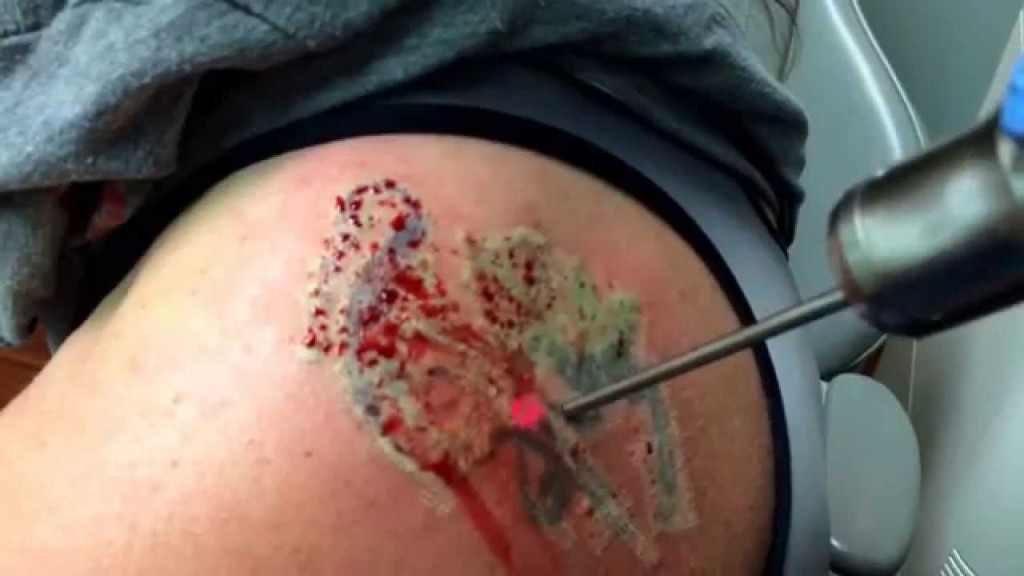
El sangrado es una reacción común e inmediata a la mayoría de los tratamientos de eliminación de tatuajes con láser.
El grado de sangrado depende de las longitudes de onda utilizadas, el nivel de potencia utilizado por el impulso del láser Q-Switching y el nivel de vascularización del área tratada por el individuo. Algunas áreas pueden estar más vascularizadas que otras. Los tratamientos con láser sin Q-Switching, como los láseres de CO2 o argón, que rara vez se ofrecen en estos días, pueden romper los vasos sanguíneos y aerosolizar (vaporizar) el tejido hasta tal punto que requiere una cubierta de plástico o un dispositivo de cono para proteger al operador del láser. Por contacto con tejidos y sangre. Se puede usar protección ocular si el operador del láser decide hacerlo.
En cualquier caso, el sangrado es menor, ya que los vasos que se rompen durante el tratamiento con láser son solo capilares superficiales. Este sangrado menor se detiene unos minutos después del tratamiento. Además, debido a la probabilidad de sangrado menor, una de las recomendaciones de las clínicas de remoción de tatuajes es no tomar aspirina o medicamentos anticoagulantes antes de los tratamientos de desvanecimiento del tatuaje (solo para evitar un sangrado un poco más prolongado).
Los procedimientos de desvanecimiento del tatuaje con láser son bastante dolorosos,, desafortunadamente, el dolor y la incomodidad no terminan ahí. Mientras que, como acabamos de ver, el dolor durante el tratamiento es un problema fácil de resolver con el uso de productos adormecedores tópicos apropiados, desafortunadamente, cualquier tratamiento con láser inflige intencionalmente una quemadura profunda en la piel para atenuar el tatuaje. Debido a esta quemadura de la piel, una consecuencia directa de cada tratamiento de desvanecimiento de los tatuajes es una lesión por quemadura infligida a propósito y de pleno derecho que requiere tiempo de curación. Esta quemadura es causada meramente por la física del láser, aunque puede atenuarse un poco, no puede evitarse variando los parámetros de funcionamiento del láser, alterando el diseño del láser o modificando la modalidad de tratamiento.

La formación de ampollas es una reacción normal a los tratamientos de desvanecimiento del tatuaje con láser. Las ampollas pueden minimizarse pero nunca evitarse por completo. Esto se debe a la naturaleza misma del tratamiento de desvanecimiento del tatuaje con láser que inflige inherentemente una quemadura en la piel para desvanecer el tatuaje.
Dependiendo del área cubierta por el tratamiento y la intensidad del tratamiento, la extensión de la quemadura de la piel causada por el láser puede ser importante a veces. Tener una quemadura de piel relativamente grande y profunda puede ser una experiencia muy desagradable e incómoda durante el proceso de curación. Como la mayoría de las quemaduras en la piel, el efecto directo de los tratamientos de desvanecimiento de los tatuajes con láser es muy intenso. El malestar suele aumentar cuando la formación de ampollas se ha formado completamente.

Ejemplo de ampollas moderadas después de un suave tratamiento con láser. La piel reacciona al tratamiento de desvanecimiento del tatuaje como lo haría después de cualquier otra quemadura de la piel. La formación de ampollas es una de las formas en que la piel reacciona a las quemaduras cutáneas con láser profundas e intensas.
Al igual que cualquier otra quemadura de la piel, la molestia dura mientras la quemadura aún esté sanando. El malestar generalmente comienza a disminuir por sí mismo a medida que las ampollas se curan, sin embargo, puede persistir cierto grado de malestar incluso después de que las ampollas hayan desaparecido y el tatuaje tratado haya cicatrizado por completo. En ciertos casos, la parte puede sentirse sensible al tacto y más sensible durante varias semanas, incluso después de que las ampollas hayan disminuido y la parte haya cicatrizado por completo.

Las ampollas aumentan de tamaño proporcionalmente con la intensidad del tratamiento con láser. Cuanto mayor es la intensidad, más grandes son las ampollas y más los niveles de incomodidad experimentados durante el proceso de curación.
Una de las razones para no tratar los tatuajes anchos de una sola vez es hacer que los clientes regresen para recibir tratamientos adicionales. Cuanto más amplia sea el área tratada con láser o cuanto mayor sea la intensidad del tratamiento, mayor será el área sometida a la quemadura de la piel, mayor será la incomodidad y el dolor experimentado durante el proceso de curación. Además, causar una quemadura en la piel en un área relativamente grande puede tener efectos secundarios como letargo y otros síntomas febriles que ocurren fisiológicamente después de grandes quemaduras en la piel.

Ampollas relativamente grandes causadas por un tratamiento de alta intensidad con láser. Cuanto mayor es el tratamiento de intensidad, más grandes son las ampollas y más incómodo es el proceso de curación.
Muy a menudo, la experiencia general desagradable a veces disuade a los clientes (a los que se hace referencia de manera incorrecta como pacientes) de someterse a todos los tratamientos necesarios para eliminarlos completamente o eliminarlos por completo. A veces, debido a los niveles de incomodidad, la mayoría de las personas prefieren someterse a la cantidad mínima de tratamientos de atenuación de tatuajes con láser que se requieren, y luego optan por un tratamiento de tatuaje tan pronto como la pigmentación se haya desvanecido lo suficiente como para que sea una opción viable.

Las ampollas después de los tratamientos con láseres se pueden minimizar, pero nunca se evitan por completo debido a la física inherente del tratamiento de desvanecimiento del tatuaje con láser.
La cantidad y el tamaño de la formación de ampollas desarrolladas durante el proceso de curación en función de la intensidad del tratamiento con láser. Cuanto mayor sea la intensidad del tratamiento, más grandes serán las ampollas y más tiempo tardará en recuperarse el área; a la inversa, cuanto más suave sea el tratamiento, más pequeña será la arena abrasadora cuanto más rápido sea el proceso de recuperación.
Si la quemadura causada por el tratamiento con láser no es demasiado intensa, el área puede curarse normalmente y el tatuaje se habrá desvanecido ligeramente después del período de recuperación. En el caso de tratamientos de muy alta intensidad, la quemadura causada por el láser también puede eliminar la mayoría de los pigmentos del tatuaje, sin embargo, la formación de ampollas será muy grande y la probabilidad de efectos adversos permanentes debido al tratamiento aumenta dramáticamente.

Un ejemplo típico de antes, fotografiado durante la formación de ampollas y después de que el área se haya recuperado por la quemadura causada por el láser.
Las ampollas comienzan a formarse 24 horas después del tratamiento, alcanzan su punto máximo dos o tres días después del tratamiento y desaparecerán gradualmente por su propia cuenta.
Es importante no interferir con el proceso de curación de las ampollas. En particular, las ampollas no deben romperse ni perforarse intencionalmente para evitar una mayor probabilidad de infecciones y otras reacciones adversas. Para obtener más información sobre el cuidado posterior adecuado para las ampollas causadas por el tratamiento de remoción de tatuajes con láser, vea el video a continuación.
Los clientes no informados a veces esperan que sus tatuajes no deseados se eliminen completamente en una sesión y con resultados perfectos. Esto es muy raramente posible mediante el uso de láseres tratamientos de desvanecimiento del tatuaje Una vez que los clientes estén informados sobre los resultados reales de este tipo de tratamiento estético, las primeras preguntas que harán serán el número de sesiones requeridas y cuánto les costará lograr los mejores resultados de desvanecimiento del tatuaje. En última instancia, estas dos preguntas están inextricablemente vinculadas. El costo total del tratamiento de remoción con láser será la cantidad de sesiones multiplicada por el costo por sesión.
No importa cuáles sean sus calificaciones o su experiencia, ningún profesional de la estética puede predecir con certeza cuántas sesiones se necesitarán para lograr los resultados deseados por los clientes. Porque hay varios factores que determinarán la cantidad de sesiones requeridas. Antes de que se lleve a cabo una prueba de parche, todo lo que un profesional experimentado en la eliminación de tatuajes puede hacer es proporcionar una estimación informada. Cualquier persona que afirme proporcionar el número exacto de tratamientos para una eliminación de tatuajes completa y sin problemas probablemente esté tratando de vender algo basado en falsas promesas.
La eliminación completa de tatuajes con láser a menudo requiere numerosas sesiones de tratamiento, por lo general espaciadas con al menos siete semanas de diferencia.. El tratamiento con más frecuencia que siete semanas aumenta la probabilidad de efectos adversos y no necesariamente aumenta la tasa de absorción de tinta. Los informes anecdóticos de sesiones de tratamientos con menos de siete semanas (cuatro semanas) conducen a más cicatrices e hipopigmentación y podrían aumentar la responsabilidad de los clínicos (especialmente en caso de que no exista un formulario de consentimiento adecuado). En cada sesión, solo una fracción de los pigmentos del tatuaje se fragmenta y se desvanece de manera efectiva durante las siguientes semanas. Las partículas grandes restantes del pigmento del tatuaje se dirigen a sesiones de tratamiento posteriores, lo que provoca un mayor alivio. El número de sesiones y el espacio entre los tratamientos depende de varios parámetros, incluida la zona del cuerpo tratada y el color de la piel. Los tatuajes ubicados en las extremidades, como el tobillo, generalmente son los más largos. Los profesionales de la estética pueden recomendar que los clientes esperen muchos meses entre los tratamientos para facilitar la resolución de la tinta y minimizar la probabilidad de efectos adversos no deseados.
En la gran mayoría de los casos, se obtienen resultados satisfactorios después de varias sesiones y los resultados rara vez son uniformes. En general, la cantidad de sesiones requeridas para lograr resultados satisfactorios de desvanecimiento puede variar de 6 a 15 dependiendo de varios factores. Algunos tatuajes se pueden quitar con mucha facilidad y se puede lograr una eliminación completamente sin problemas en una o dos sesiones (este es generalmente el caso de ciertos tatuajes de maquillaje permanentes de alta calidad), sin embargo, esta no es la norma.. La mayoría de los tatuajes pueden ser extremadamente resistentes y puede ser incluso poco práctico o no recomendable intentar y lograr una eliminación completa. Algunos fabricantes de remoción de tatuajes con láser afirman que sus últimos dispositivos eliminan todos los tatuajes en una sesión sin reacciones adversas permanentes, estas reclamaciones no están verificadas.
Si bien algunos tatuajes se eliminan fácilmente en pocas sesiones (especialmente el maquillaje permanente), a pesar de las afirmaciones hechas por los fabricantes de láser, no hay evidencia de que todos los tatuajes se puedan eliminar dentro de un tratamiento sin dejar una cicatriz visible, hipo-pigmentación u otro tipo de permanente Cambio en la textura de la piel. La eliminación completa de tatuajes sin problemas es más la excepción que la norma, especialmente debido a la forma en que se han dibujado los tatuajes originalmente. En el caso de pigmentos de tatuaje particularmente resistentes, un cierto grado de desvanecimiento del tatuaje se considerará un buen resultado, ya que la remoción completa sin dejar cicatriz o textura permanente en la piel puede ser poco probable.
Entonces, ¿cuáles son los factores más importantes para determinar la cantidad de sesiones, especialmente en los procedimientos de desvanecimiento de tatuajes con láser? La mayoría de los factores ya se han cubierto en detalles enla sección general de desvanecimiento del tatuaje.. Es recomendable que revise estos puntos antes de continuar leyendo. Para revisar estos puntos por favor HAGA CLICK AQUÍ. Algunos de los puntos a continuación son particularmente típicos de los tratamientos de desvanecimiento de tatuajes con láser solamente:
- La intensidad de los tratamientos. l igual que con cualquier otro tipo de procedimiento de desvanecimiento del tatuaje, cuanto mayor es la intensidad del tratamiento, mayor es el grado de desvanecimiento del tatuaje después de cada sesión y, por lo tanto, menos sesiones se requieren para lograr un desvanecimiento satisfactorio. Por otro lado, cuanto mayor sea la intensidad del tratamiento, mayor será la probabilidad de efectos adversos no deseados permanentes, como hipopigmentación, cambio permanente en la textura de la piel y cicatrización. A la inversa, cuanto más suave sea la intensidad del tratamiento, menos se desvanecerá el tatuaje después de cada tratamiento y, por lo tanto, se requerirán más sesiones.
- Un número de longitudes de onda utilizadas por el dispositivo. Esto es peculiar a los tratamientos de desvanecimiento de tatuajes con láser solamente. Como sabemos, los láseres son dispositivos que pueden emitir un número discreto de longitudes de onda a la vez (ya sea una, dos, tres, etc.). Algunos fabricantes han diseñado láseres multifrecuencia que pueden emitir varias frecuencias diferentes al mismo tiempo. Esto es un esfuerzo por eliminar todos o la mayoría de los colores de tatuajes lo más rápido posible. Los láseres de desvanecimiento de tatuajes de múltiples longitudes de onda tienen una tendencia generalmente natural a desvanecer los tatuajes más que los láseres de frecuencia de longitud de onda mono. Esto se debe a que cuanto mayor sea la longitud de onda utilizada por el láser, mayor será la intensidad del tratamiento y más se desvanecerá el tatuaje después de cada sesión. A medida que aumenta la intensidad del tratamiento, aumenta la probabilidad inherente de reacciones adversas permanentes. A la inversa, las longitudes de onda mono (o los láseres de monofrecuencia) desvanecerán el tatuaje en menor medida después de cada tratamiento.
- Colores del tatuaje. Como es bien sabido, a diferencia de otros tratamientos de desvanecimiento de tatuajes, los láseres desvanecen los colores a diferentes ritmos y algunos colores pueden ser particularmente difíciles de desvanecer. Por lo tanto, los tatuajes más coloridos y brillantes son los más desafiantes y serán necesarias más sesiones. Mientras que los tatuajes más oscuros pueden requerir menos tratamientos para lograr una decoloración satisfactoria.
- Tono de la piel. Los tonos de piel más oscuros son más propensos a desarrollar hipopigmentación después de los tratamientos con láser. Por esta razón, mientras más oscuro sea el tono de la piel, más suave será el tratamiento con láser para tratar de evitar que esto ocurra. Debido a que la hipopigmentación es la única razón por la que la intensidad del tratamiento con láser y otros tipos de tratamientos de desvanecimiento no suelen mostrar este tipo de reacción adversa, los tonos de piel más oscuros pueden beneficiarse de otros tratamientos de desvanecimiento de tatuaje tipificados que no conducen a Hipo-pigmentación.
A veces, las estimaciones basadas solo en la experiencia previa pueden ser completamente poco fiables. La mejor manera de estimar el número de sesiones requeridas para lograr los resultados deseados es una extrapolación después de apreciar los resultados de una prueba de parche o después de la primera sesión. Esto se debe a que cada tatuaje es diferente y rara vez hay poca información de fondo sobre el tatuaje en sí y la forma en que se hizo originalmente.
Hay varios factores que determinan la cantidad de sesiones requeridas para lograr los resultados deseados.. Los factores que influyen en esto incluyen el tipo de piel, ubicación, color, cantidad de tinta, cicatrización o cambio de tejido, capas de tatuajes, etc. Dado que la cantidad de sesiones de tatuaje con láser necesarias para lograr los resultados deseados es una pregunta frecuente, una escala predictiva, el "Kirby -Desai Scale ", fue desarrollado por el Dr. Will Kirby y el Dr. Alpesh Desai, dermatólogos con especialización en técnicas de remoción de tatuajes, para evaluar el éxito potencial y la cantidad de tratamientos necesarios para la remoción de tatuajes con láser, siempre que el médico esté usando una Nd Q-switche : Láser YAG (granate de itrio-aluminio dopado con neodimio) que incorpora fototermólisis selectiva (es decir, el uso de la luz producida por los láseres para producir daño por calor) con seis semanas entre tratamientos.he use of light produced by lasers to produce heat damage) with six weeks between treatments.
La Escala Kirby-Desai asigna valores numéricos a seis parámetros: tipo de piel, ubicación, color, cantidad de tinta, cicatrización o cambio de tejido y capas. Luego se agregan las puntuaciones de los parámetros para obtener una puntuación combinada que mostrará la cantidad estimada de tratamientos necesarios para un desvanecimiento satisfactorio del tatuaje. Algunos recomiendan que todos los profesionales del láser utilicen la escala Kirby-Desai antes de comenzar el tratamiento de eliminación de tatuajes para ayudar a estimar la cantidad de tratamientos necesarios para la eliminación de tatuajes y como factor predictivo del éxito de los tratamientos de eliminación de tatuajes con láser. Antes de 2009, los médicos no tenían una base científica (aparte de las pruebas de parches) para estimar la cantidad de tratamientos necesarios para eliminar un tatuaje y el uso de esta escala es ahora una práctica estándar en la eliminación de tatuajes con láser.
El video a continuación sirve para proporcionar un ejemplo de los verdaderos resultados de desvanecimiento que se pueden lograr después de los tratamientos suaves de desvanecimiento con tatuajes con láser. Este video puede servir para gestionar las expectativas de los clientes cuando se someten por primera vez a tratamientos de desvanecimiento de tatuajes.
A primera vista, la mayoría de los anuncios de eliminación de tatuajes con láser parecen prometer resultados de desvanecimiento total de tatuajes. No se debe culpar a los profesionales de marketing por este concepto erróneo inicial acerca de los procedimientos de eliminación de tatuajes con láser, ya que esto es lo que atrae a las personas en primer lugar. Comercializar los resultados reales y las expectativas reales de los tratamientos con láser no sería muy efectivo y podría disuadir a las personas de preguntar por el tratamiento para empezar. Desafortunadamente, las campañas de marketing que se centran en los resultados reales no son muy efectivas en el mundo comercial, especialmente cuando a primera vista todas las clínicas principales sugieren resultados de remoción sin problemas. Por lo tanto, la expectativa inicial común del cliente desinformado es la eliminación completa y perfecta de sus tatuajes en una sola sesión fácil. Sin embargo, como sabemos, esto rara vez es la realidad de los resultados de los tratamientos de remoción de tatuajes con láser, como lo demuestran los términos de negocios presentados antes de los tratamientos.

Ejemplo de anuncio de eliminación de tatuajes común. Estos están diseñados para captar la atención de la audiencia, sin embargo, estas afirmaciones no pueden reflejar lo que actualmente es posible lograr en la realidad.
De hecho, actualmente no existen dispositivos o técnicas de eliminación de tatuajes con láser que puedan garantizar resultados uniformes y consistentes. A veces es posible eliminar ciertos tipos de tatuajes usando láseres en una o muy pocas sesiones, sin embargo, esta es la excepción y no la norma; también los tratamientos de muy alta intensidad hacen posible la desaparición del tatuaje para la mayoría de los tatuajes en muy pocas sesiones, sin embargo, esto aumenta la probabilidad de causar quemaduras intensas en la piel que darán lugar a reacciones adversas permanentes muy visibles (principalmente cicatrices, hipopigmentación y cambio permanente de la textura de la piel)
Cuando los pigmentos se encuentran demasiado profundos en la dermis o, en el caso de tatuajes de varias capas, la eliminación perfecta puede ser altamente improbable en cualquier caso. Esto se debe a que la ablación tiene que realizarse tan profundamente dentro de la dermis para eliminar toda la pigmentación que la probabilidad de reacciones adversas permanentes es muy alta. Por lo general, estos tipos de tatuajes se pueden desvanecer hasta cierto punto, sin embargo, la desaparición completa es muy poco probable. De manera más general, como regla general, cuanto más altos sean los puntos en la escala de Kirby-Desai, más improbable será una eliminación completa sin problemas. Por el contrario, cuanto más bajos sean los puntos, más probable será que se elimine sin problemas. Un ejemplo de tatuaje de puntos bajos es el maquillaje permanente, que generalmente se quita en una o dos sesiones.
Como sabemos, los tratamientos de desvanecimiento con tatuajes con láser consisten en causar una quemadura en la piel del área tatuada para dispersar los pigmentos de color. La piel no reacciona bien tanto a corto como a largo plazo a las quemaduras de la piel. Por lo tanto, debido a la naturaleza misma de este tipo de tratamiento estético, los resultados continuos después de una eliminación completa son más la excepción que la regla. Conscientes de la alta probabilidad de reacciones adversas permanentes al tratamiento con láser, muy pocas clínicas cosméticas están dispuestas a garantizar resultados ininterrumpidos, a pesar de las afirmaciones (implícitas o explícitas) realizadas durante las campañas publicitarias. Esto se debe a que los profesionales de la estética experimentados son muy conscientes de la naturaleza de los tratamientos con láser y de lo que se espera de este tipo de tratamientos de desvanecimiento de tatuajes. Los resultados reales esperados también surgen en los formularios de consentimiento informado, que las clínicas utilizan para minimizar sus posibles responsabilidades debido a las reacciones adversas reales permanentes. A menudo, puede haber un cambio en la textura de la piel que puede ser permanente, hipopigmentación, dispersión de color, un rastro de la pigmentación anterior o el tatuaje no se eliminará por completo, ya que puede ser impráctico hacerlo sin dejar una cicatriz.
Se debe informar al cliente sobre lo que se puede esperar de los tratamientos de desvanecimiento con láser de tatuaje. Algunos de los efectos adversos permanentes de los tratamientos de desvanecimiento de tatuajes con láser son:
- Hipopigmentación . La hipopigmentación asociada con algún tipo de cambio en la textura de la piel es el efecto adverso permanente más común de las quemaduras causadas por los láseres. No suele ocurrir después de otros tratamientos de desvanecimiento del tatuaje. La hipopigmentación asociada con algún tipo de cambio en la textura de la piel es el efecto adverso permanente más común de las quemaduras causadas por los láseres. La probabilidad de hiperpigmentación se ve agravada en los tipos de piel oscura, y esta es la razón por la que muchos tratamientos suaves se usan en tonos de piel oscuros. Algunas clínicas incluso prefieren evitar los tratamientos con láser en los tipos de piel 4, 5 y 6.
tonos de piel

A veces se evita el tratamiento estético con láser en los tipos de piel 4, 5 y 6 debido a la posibilidad de hipopigmentación. Aquellas clínicas que realizarían tratamientos con láser en estos tonos de piel más oscuros realizan tratamientos muy suaves, a fin de minimizar la posibilidad de hipopigmentación.
Especialmente en los tonos de piel más oscuros, la probabilidad de hipopigmentación es tan alta que algunas clínicas cosméticas no sugieren tratamientos con láser. En caso de piel oscura, el profesional de la estética todavía puede informar a los clientes sobre las posibles reacciones adversas inherentes (especialmente la hipopigmentación) y si los clientes aceptan que realizan el tratamiento con láser menos invasivo para minimizar los riesgos de la hipopigmentación, incluso si el número Los tratamientos requeridos para lograr los resultados deseados aumentan dramáticamente (a veces exceden los tratamientos en caso de tatuajes resistentes). Es muy probable que ocurra la Hipopigmeantación especialmente después de intensas longitudes de onda múltiple o tratamientos de muy alta intensidad. A veces puede ser temporal, sin embargo, en su mayoría es permanente. Muchas personas prefieren tener una Hipopigmeantación en lugar de mantener su tatuaje no deseado. La hipopigmentación a veces se resuelve con un maquillaje de camuflaje permanente (otra forma de tatuaje).
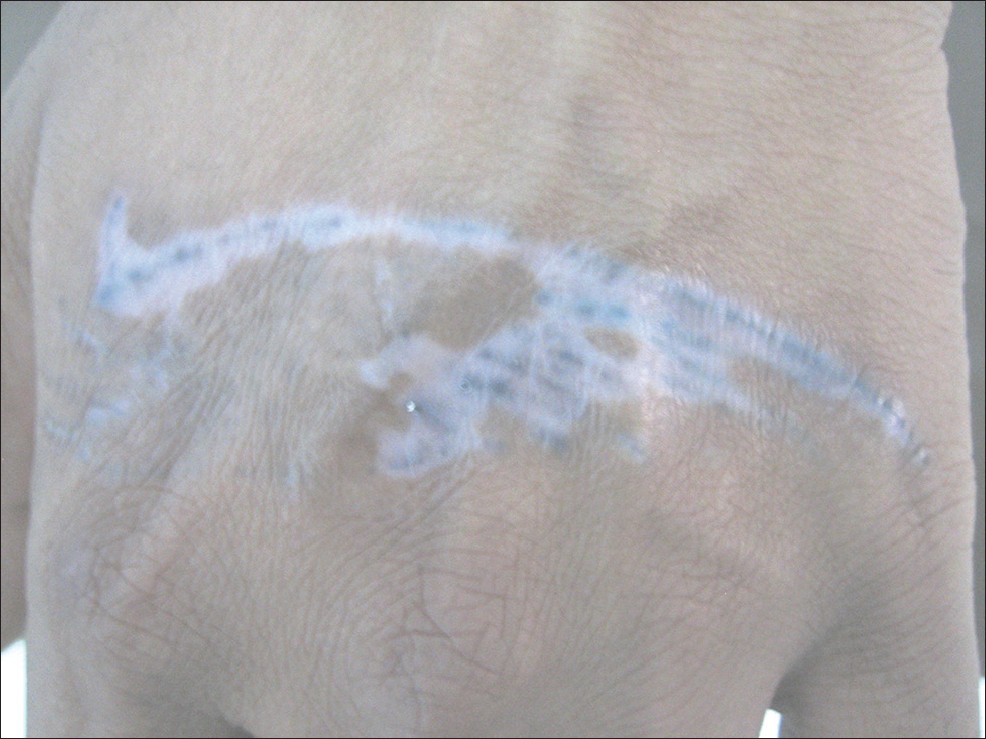
Hipopigmentación que queda tras el tratamiento de desvanecimiento del tatuaje. Algunos pigmentos azules todavía están presentes. La mayoría de las hipopigmentaciones son permanentes, sin embargo, este tipo de hipopigmentación se desvanecerá ligeramente con el tiempo. Por otro lado, es poco probable que la textura de la piel se mezcle completamente con el resto de la piel.
- Hiperpigmentación.. Esto puede ocurrir porque el tratamiento de desvanecimiento del tatuaje también desencadena la regeneración de la piel. Como es bien sabido, la exposición a la luz solar sin protección solar puede causar hiperpigmentación. En ciertos casos, algunos colores claros como el amarillo o el blanco pueden volverse oscuros. Este oscurecimiento paradójico puede llevar a un cambio estético. Estos colores se pueden eliminar con otras sesiones de láser.
- Cambio permanente de la textura de la piel. Esto ocurre especialmente después de tratamientos con láser intenso. Apariencia arrugada o leve efecto de profundidad en la piel en el caso de tatuajes en 3D. Esta es una característica común de los tratamientos de desvanecimiento de tatuajes con láser y también puede ocurrir después de otros tipos de tratamientos de desvanecimiento de tatuajes.
- Puede causar cicatrices especialmente hipertróficas.. La probabilidad de desarrollo de cicatrices hipertróficas se ve agravada por los tratamientos de alta intensidad que utilizan láseres de múltiples longitudes de onda. Sin embargo, la causa principal de la cicatrización permanente es la falta de cuidados posteriores o la predisposición a la cicatrización. Este tipo de reacciones adversas pueden ocurrir después de cualquier tipo de tratamiento de desvanecimiento del tatuaje.
- Formación de queloide. Esto también puede ocurrir después de cualquier otro tipo de tratamiento de desvanecimiento del tatuaje.
- Eliminación incompleta, incluso imposible, de todos los rastros de tinta de tatuaje. Los tatuajes policromos, en particular, el color pastel, la pigmentación amarilla y densa o profunda del tatuaje son particularmente difíciles de desvanecer por completo. Se puede observar un tatuaje fantasma (vestigios residuales) al final del curso de varios tratamientos.
- Fototoxicidad de ciertos tipos de pigmentos de tatuaje. Algunos pigmentos para tatuajes contienen metales que, en teoría, podrían descomponerse en químicos tóxicos dentro del cuerpo cuando se exponen a la luz (incluido el de los láseres). Esto aún no se ha informado en vivo, pero se ha demostrado en pruebas de laboratorio.
Cuanto mayor es la intensidad del tratamiento, más dispersa la pigmentación del tatuaje por el tratamiento, sin embargo, mayor es la probabilidad de desarrollar reacciones adversas permanentes adversas debido a la quemadura profunda causada por el tratamiento con láser de alta intensidad. A la inversa, cuanto más leve sea el tratamiento, más leve será la quemadura infligida, menor será la dispersión de la pigmentación y menor será la probabilidad de desarrollar reacciones adversas permanentes después de cada tratamiento individual. Por esta razón, la mayoría de las clínicas de estética prefieren dividir el tratamiento de remoción en varios tratamientos de baja intensidad. Esto no solo minimiza la probabilidad inherente de desarrollar reacciones adversas, sino que también aumenta el precio general del tratamiento de desvanecimiento del tatuaje debido al aumento del costo acumulado de varias sesiones.
Debe recordarse que, aunque los tratamientos leves minimizan la posibilidad de reacciones adversas, debido a los daños acumulados en la piel causados por las quemaduras con láser, también un alto número de tratamientos con láser puede provocar efectos adversos. En otras palabras, debido a que el daño acumulado de varias quemaduras con láser relativamente leves puede causar reacciones adversas permanentes similares a uno o pocos tratamientos con láser intenso.
Tenga en cuenta que cualquier reacción adversa permanente puede ocurrir independientemente de la forma en que se haya realizado el tratamiento. A veces, incluso un tratamiento con láser relativamente suave puede desencadenar una o más reacciones adversas. Desafortunadamente, actualmente no se conoce un tratamiento de desvanecimiento del tatuaje capaz de garantizar la eliminación perfecta del tatuaje.
En esta sección, podemos ver algunos resultados reales de los procedimientos de desvanecimiento (remoción) de tatuajes con láser. Por supuesto, en algunos casos donde el tatuaje tiene una puntuación baja en la escala de Kirby-Desai, los resultados pueden ser perfectos, sin embargo, esta no es la realidad de la mayoría de los tratamientos de desvanecimiento de tatuajes, especialmente aquellos que tienen una puntuación alta de Kirby-Desai. Cuanto más difícil sea eliminar el tatuaje, es decir, cuanto más altos sean los puntos en la escala de Kirby-Desai, más probabilidades habrá de que la eliminación de los pigmentos del tatuaje tenga el precio de algún tipo de reacción adversa. Principalmente presentamos los resultados que muestran una hipopigmentación porque es la reacción adversa permanente más común a los tratamientos de remoción de tatuajes con láser. No todos los procedimientos de desvanecimiento con láser presentarán reacciones adversas y algunos tatuajes se pueden eliminar a la perfección, sin embargo, este es solo el caso de los tatuajes de alta calidad, y los tatuajes con una puntuación baja de la escala de Kirby-Desai.

Hipopigmentación típica y cambio en la textura de la piel después de un intenso tratamiento con láser. La hipopigmentación es una reacción adversa exclusiva de los tratamientos con láser, hasta el momento no se ha informado después de ningún otro tipo de tratamiento de desvanecimiento del tatuaje.
La hipopigmentación suele ser permanente, pero lentamente mejora con el tiempo. La piel hipopigmentada de color rosa normal se encuentra después de la curación normal de la mayoría de las heridas. El tipo de hipopigmentación permanente causada por los tratamientos con láser no debe confundirse con la falta temporal normal de melanina después de una cicatrización normal de la herida. Esto se debe a que, desafortunadamente, los tratamientos con láser parecen tener la tendencia inherente de destruir permanentemente los melanocitos o de alguna manera inhibir de forma permanente la producción natural de melanina.

Hipopigmentación dispersa por tratamiento con láser. Por lo general, este es un riesgo inherente que a veces puede ser inevitable. Cuanto más oscuro sea el tipo de piel, mayor será la probabilidad de desarrollar hipopigmentación después de los tratamientos de desvanecimiento con láser para tatuajes.
Como se ve en la figura anterior, la falta de melanina puede ocurrir en parches al azar en el área tratada por el láser. Cuanto mayor sea la intensidad del tratamiento, mayor será la probabilidad de este tipo de efecto adverso.
La hipopigmentación es más difícil de eliminar o atenuar que la mayoría de los otros tipos de reacciones adversas a los tratamientos de desvanecimiento de tatuajes con láser. Esto se debe a que la falta inherente de melanina, aunque puede mejorar ligeramente con el tiempo, es permanente y actualmente no se conocen métodos para restablecer la producción natural de melanina después de que la quema con láser la haya inhibido. Si bien la hiperpigmentación, la cicatrización, los queloides y ciertos tipos de cambios en la textura de la piel pueden tratarse con éxito de varias maneras, la hipopigmentación puede mejorar ligeramente con el tiempo por sí sola, pero desafortunadamente, no se conocen tratamientos estéticos para revertirla. La solución más común para la hipopigmentación es el encubrimiento de tatuajes o el maquillaje permanente.

La hipopigmentación y variación es el tono y la textura de la piel; en general, es una reacción cutánea permanente muy común a los tratamientos de tatuaje con láser. En la figura de arriba podemos ver cómo los colores más brillantes siguen presentes después de 5 tratamientos con láser.
El maquillaje de camuflaje permanente es una buena solución para aquellas áreas que rara vez se exponen a la luz solar. Debido a que la exposición al sol oscurecerá naturalmente la piel sana y normal, mientras que el área hipopigmentada no cambiará de color, por lo tanto, la exposición a la luz solar y el bronceado artificial pueden acentuar el problema estético incluso después del uso de tatuajes de cobertura o maquillaje permanente. . Por lo tanto, la solución más común a esta reacción adversa es tatuar las áreas hipopigmentadas con otro color para mezclarlas en el área hipopigmentada.
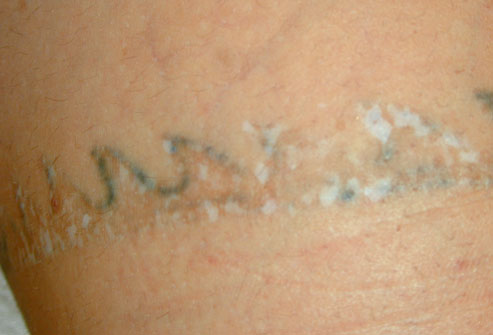
Un ejemplo más de hipopigmentación. Como podemos ver algunos rastros de pigmentación todavía están presentes.
Debido a la alta probabilidad de cambio en la textura de la piel, cicatrización e hipo-pigmentación, muchas personas prefieren desvanecer el tatuaje ligeramente con un láser. Por lo general, solo se someten a aquellos tratamientos que se desvanecen en la mayoría de los colores.
La siguiente experiencia se presenta como ejemplo para mostrar los resultados reales de los tratamientos con "remoción de tatuajes" con láser. Como verá en estos tres videos, el proceso de curación se acompaña de ampollas y es incómodo. En el tercer video, la "imagen" anunciada como segura y más efectiva que los láseres comunes ha provocado ampollas que duraron 5 días y, posiblemente debido al tratamiento de alta intensidad, la última sesión dejó un cierto grado de hipo-pigmentación.
Hemos elegido estos videos porque son un verdadero testimonio de lo que pasan los clientes después de los tratamientos de remoción con láser. Como puede ver en estos videos, las reacciones normales inmediatas y temporales son las descritas anteriormente en esta página web (ampollas e incomodidad).
En este video, puede ver los resultados reales de un tratamiento realizado con una "imagen" de desvanecimiento / "eliminación" de tatuajes muy costosa y altamente publicitada.
Hay varios videos más publicados en las redes sociales y todos muestran experiencias similares.
Tome el examen de eliminación de tatuajes – Haga clic aquí
[:]

